All content © Axel Antas unless otherwise stated.
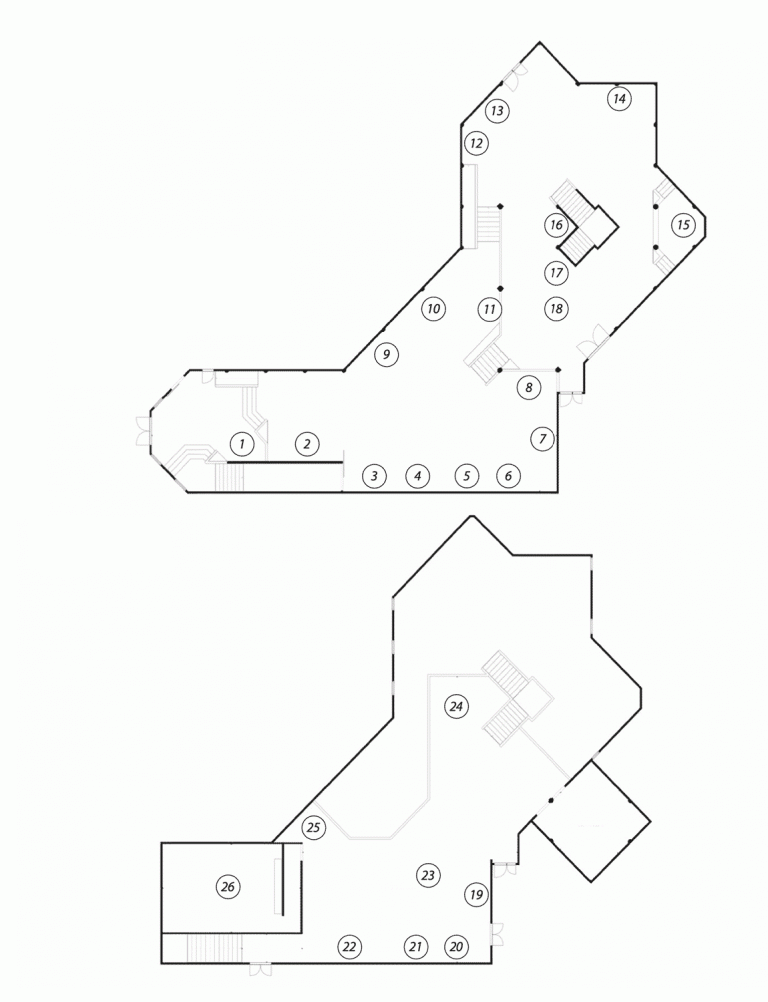
Untitled (Butterflies) , C-print, 2019
Kaleidoscope (Drop) , C-print, 2019
Still Life (Inertia Geometry)
Digitised Super 16 mm film, 2023
Untitled (Sketch of a Tree)
Super 8 mm film, pencil on paper, 2010
A Passenger Pigeon Flying (After Eadweard Muybridge) HD video, 2021
Lines Describing a Circle
Digitised Super 16 mm film, 2017
Long Player
3-channel video, 16mm film digitised, analogue player, photograph, 2015
Structure for Birds (Field)
C-print, 2007
Haptic Perception (Breath)
C-print, 2021
Haptic Perception (Ode to Touch)
C-print, 2021
New to Nature No. 1: Stiphrornis pyrrholaemus
Pencil on paper, 2019
Eiao Monarch
Bronze and concrete, 2021
Vermilion Flycatcher
Bronze and concrete, 2021
Lost to Sight
(Least Vermilion Flycatcher) C-print, 2019
Diurnal Landscape
Computer-generated animated imagery
Sound
Duration 22.5 – 27.7 2023
“Nothing is Made, Nothing Disappears” is Axel Antas’ first solo museum exhibition in Finland. The works in the exhibition are predominantly from the last few years, but they nevertheless provide a comprehensive account of the themes he has been working on during his 20-year career. There are also new works, including photographs, drawings and video works, which he has completed this year. Antas is a multidisciplinary artist working in a wide range of media and techniques.
“Nothing is made, nothing disappears. The same changes, at the same places, never stopping.” The phrase is from the poetry book The Shape (2012) by Serbian poet and philosopher Dejan Stojanović. In his poem, Stojanović draws on the 17th-century French chemist Antoine Laurent de Lavoisier, known as a witness to the law of the indestructibility of matter. The origins of these ideas, in turn, can be traced back to the Pre-Socratic Greek philosopher Anaxagoras, who believed that mass existed at the beginning of everything.
According to Antas, art must offer something more than a fleeting experience, a glimpse of a feeling or a glance of another reality. To consider the title of the exhibition transports the viewer to other times and places. “Nothing is Made, Nothing Disappears” sums up the idea of the exhibition, everything that exists is in constant change and thus pointing to our relation to the fragility of time.
Time and the concept of time are recurring themes throughout the exhibition. In Antas’ works, the perspective of time changes imperceptibly from the past to the present and the future. He creates and oscillates with time and space in his work, allowing the viewer to slowly piece together the small fragments of intimate moments, or at other times, to become completely immersed in monumental imaginary spaces.
Antas’s works require an unhurried approach, they take time to gradually reveal their ideas to the viewer. The viewer has to stop at the whiteness of the image and adapt to its immateriality and infinity. It is as if the artist wants the viewer to remember that understanding and learning takes time. It is rewarding, because the moment of experiencing the work lingers long after the first encounter. We carry the experience with us to other times and places. Antas emphasises the meditative process of both producing and receiving art. The exhibition emphasises a focus on the moment, with the viewer at the centre.
The techniques of the works in the exhibition can also be linked to time, from the Renaissance to the present. In a series of new drawings, Antas has used the metalpoint technique popular in the Renaissance era. The drawings are made on primed paper using pencils with sharp metal of pure bronze and silver. The silver pencil drawing is juxtaposed with the white colour seen in other works in the exhibition. In his video works and photographs, Antas has drawn on different stages of technological development, using both analogue and digital techniques.
The exhibition is linked to nature and the environment, themes Antas has persistently worked with for a long time. He explores our relationship with nature in depth and observes our alienation from it. In Antas’ work, nature acts as a mirror and reflection of our existence. Virtuality and digitality are having an ever-increasing impact on people’s lives. Our relationship with time has changed and time is also an important part of our experience of nature. Conversely, contact with our own physicality is becoming more blurred, the tangible connection with nature is fading. Antas aims to highlight this change, emphasising understanding based on lived experience and sensory perception.
Observations of time, space and presence are characteristic of Antas’ art. The places where the works are shot and the events that take place are important to the artist. He pays attention to detail in a way that the viewer can also identify with. There is something mournful in the poetic atmosphere of the works. On the other hand, there is also an absurdity and a surrealism that adds a lightness, even a comic quality.
“Nothing is Made, Nothing Disappears” is a reminder of perpetual change: everything is interconnected and always moving and changing. Antas is urging us to pause, to stop and reflect, and to be aware and mindful of this moment.
Mari Lehtosalo – Poikilo Museum
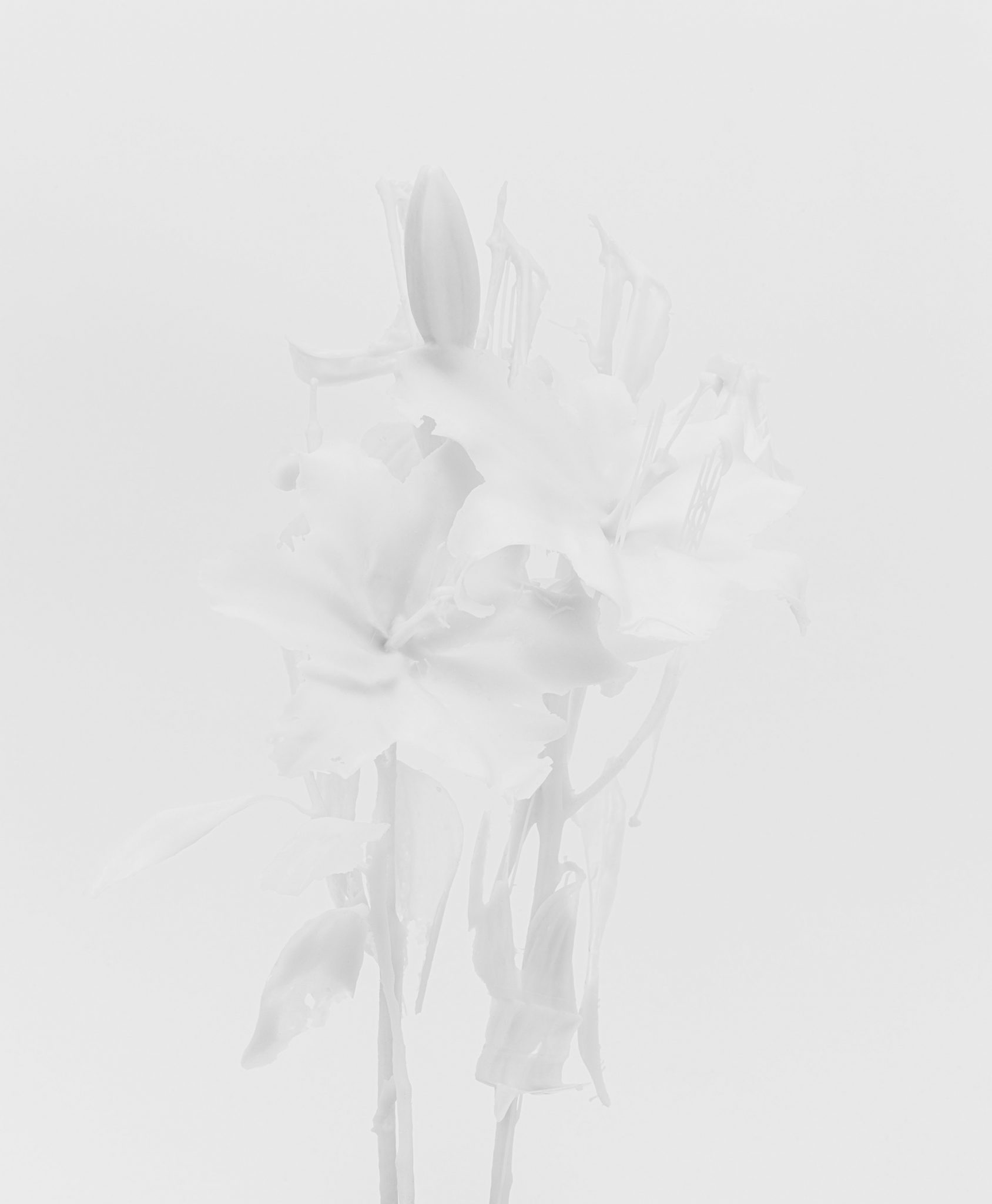
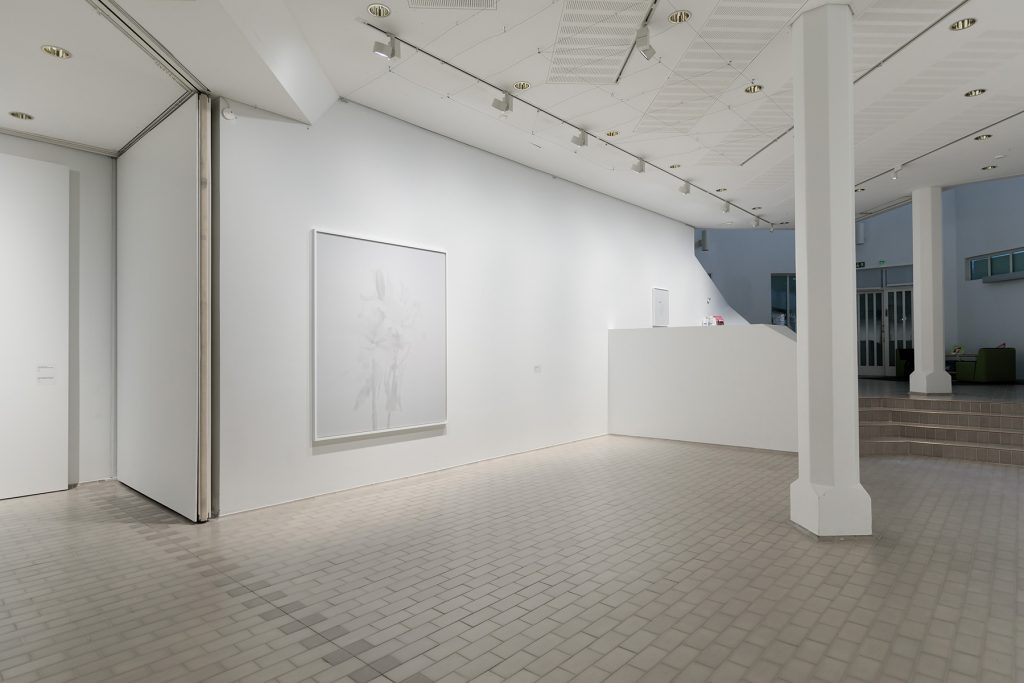
In this series of monochrome images of plants, Axel Antas explores temporality and process. Akin to still life, these plants have been gradually removed from real life. Over several weeks, Axel Antas has been photographing tulips and irises in his studio on a daily basis. He then assembled these images of both exuberant and wilted flowers into an abstracted image. The plants have gone through a digitisation process and the artist then turns this combined image into a 3-D print in resin that he ultimately photographs in the studio.
As a result, the resin objects have various defects in them, visible in the form of supports for the smallest parts of the structure and small flaws in the leaves. Hence, the many different stages, each one a removal, a step further away from the original reference point, the object. The plants have been evolved into new flowers, so to say, copies of themselves. In these futuristic flowers, the copies of the flower thus merge becoming part of the flower itself, giving the impression that the flower both lives and dies in the same plant.
The final images lack contrast, making them almost transparent. These images appear almost abstract at first glance, yet on closer inspection they are full of details. Its is both timeless and processual, emphasising both the cycles of creation and decay. Antas demonstrates everything is in constant transformation.
– Camilla Granbacka, Helsinki 2023
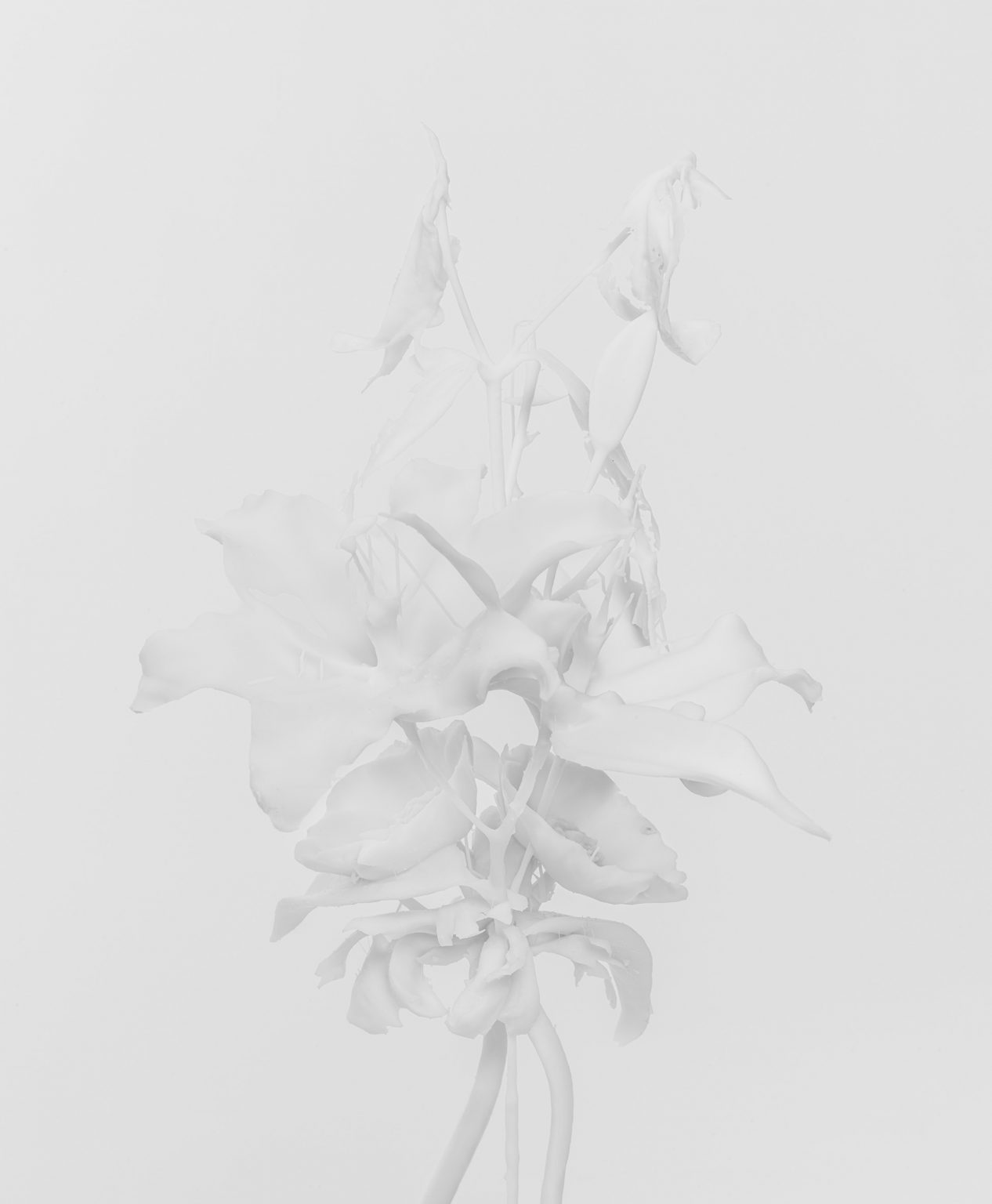
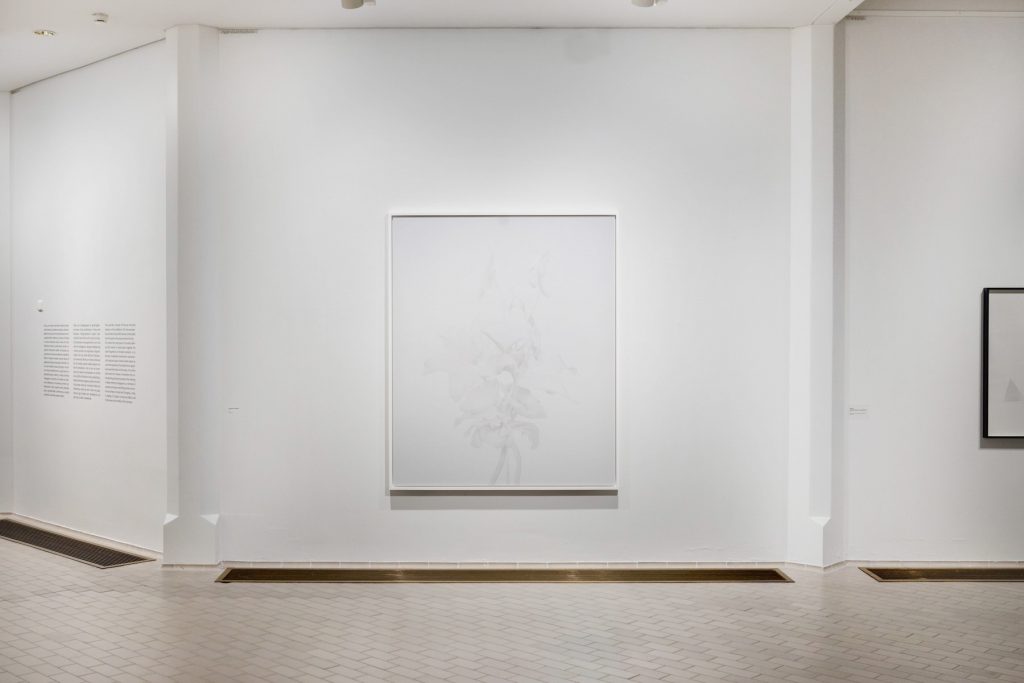
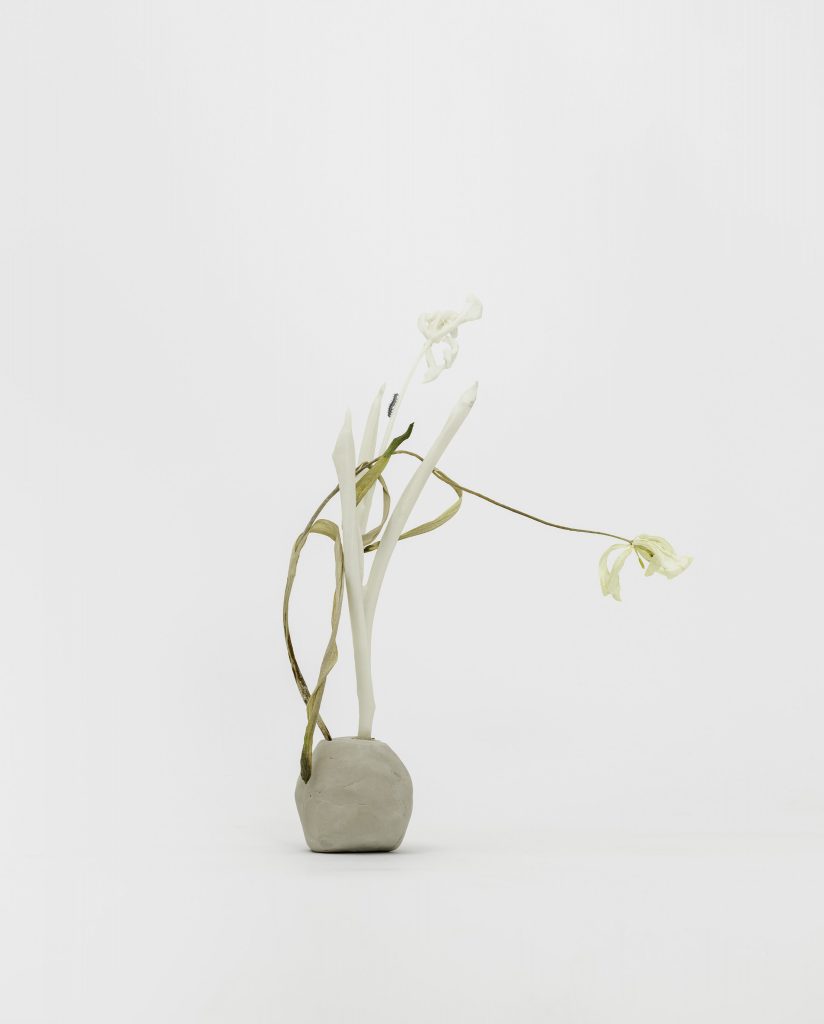
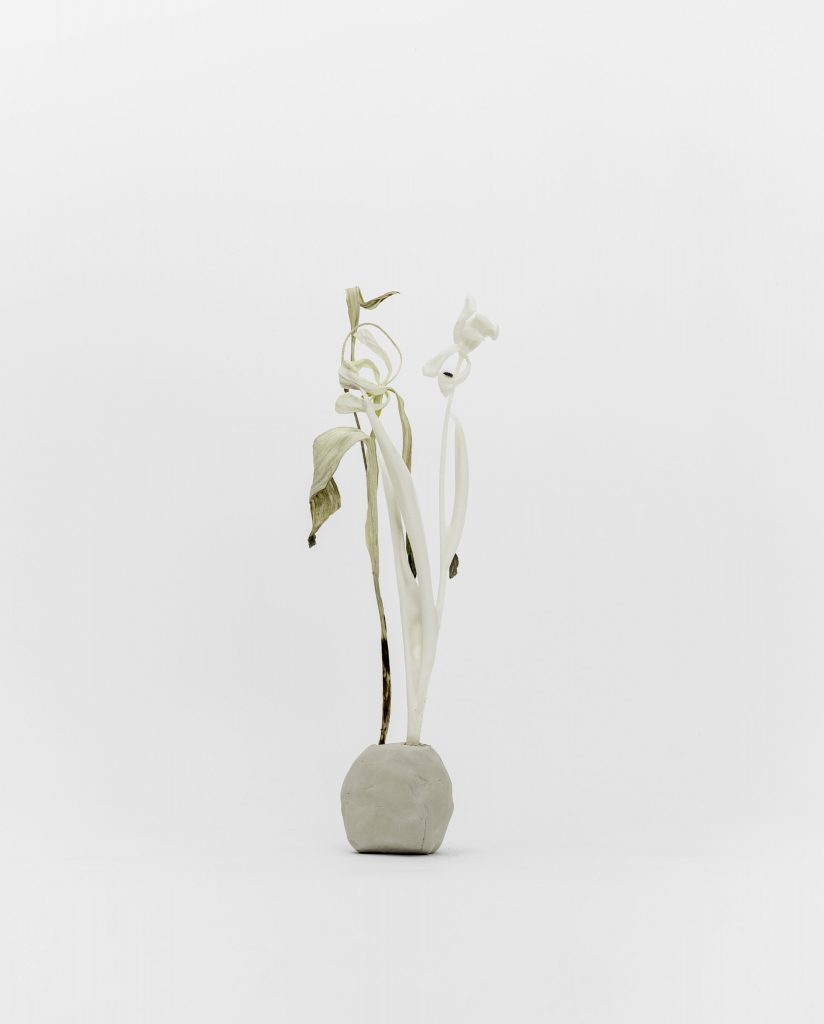
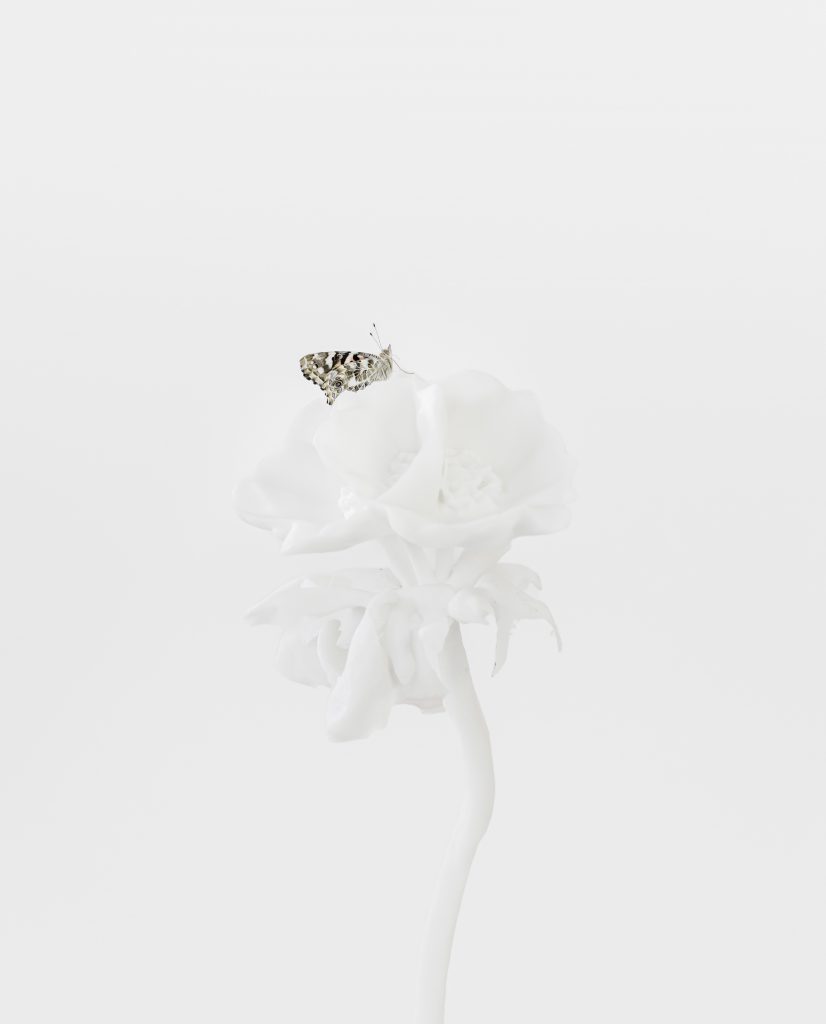
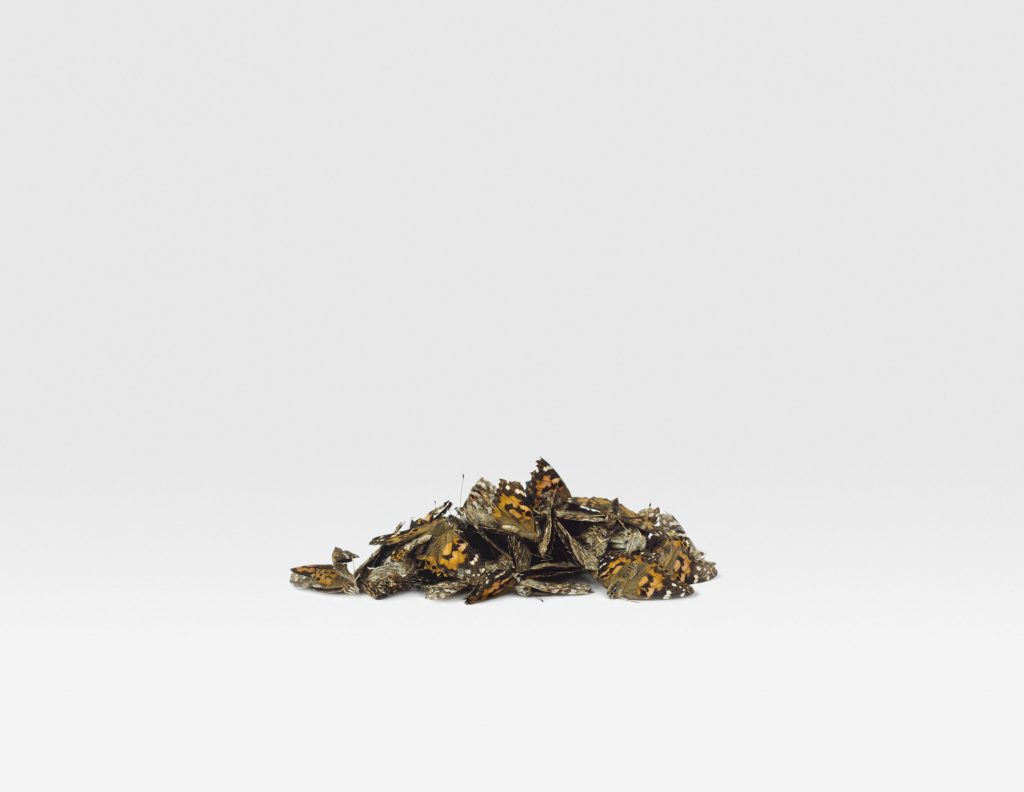
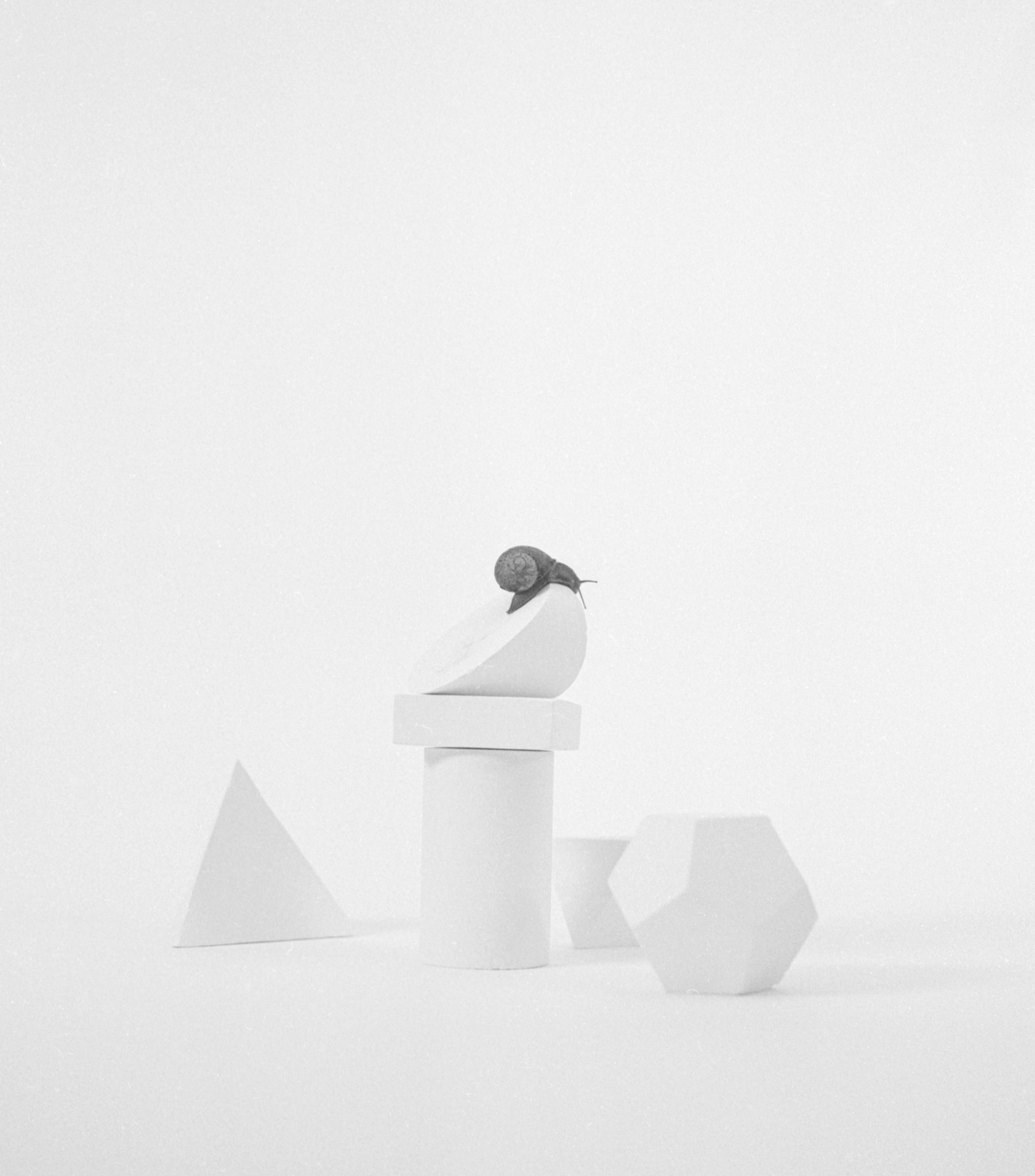
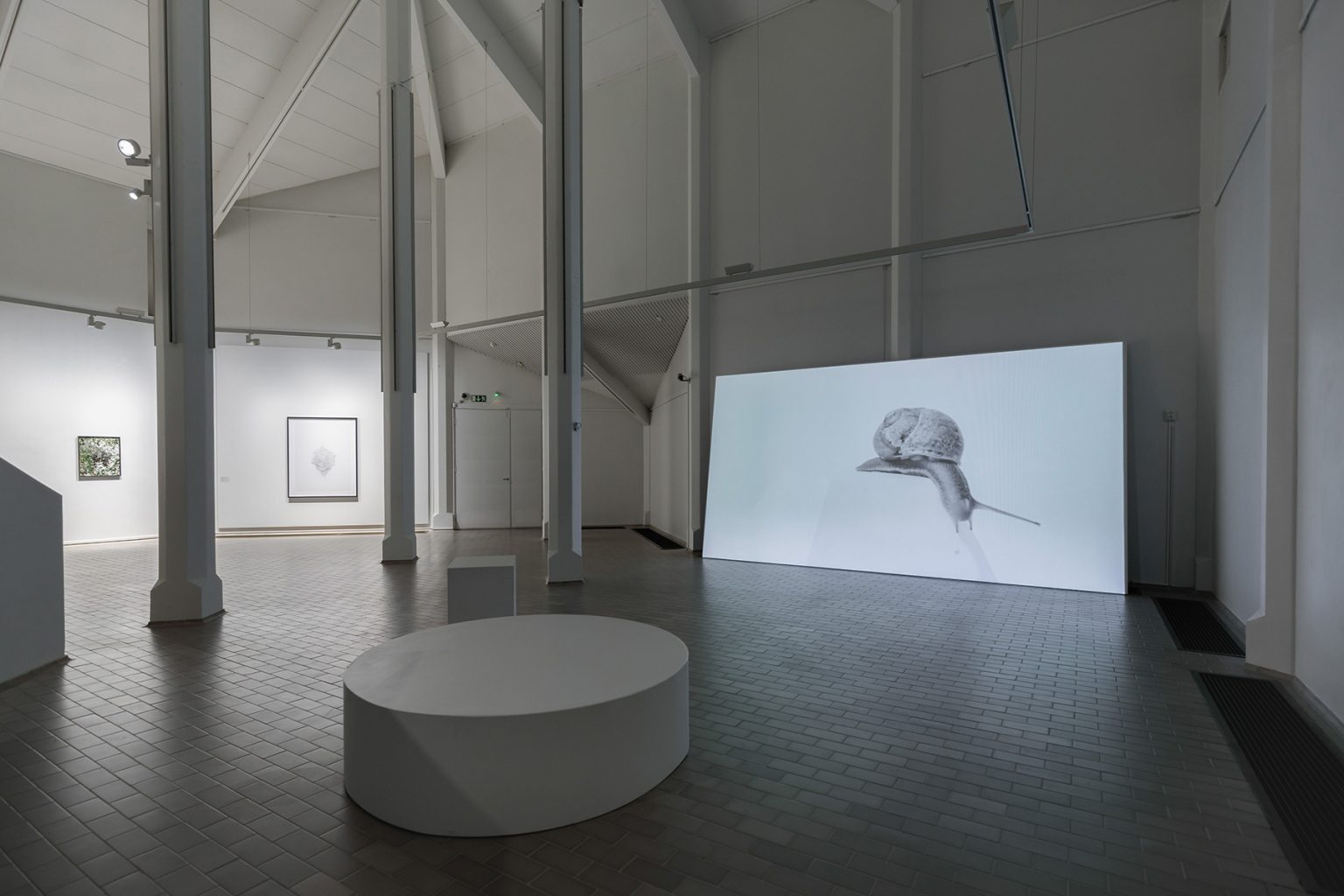
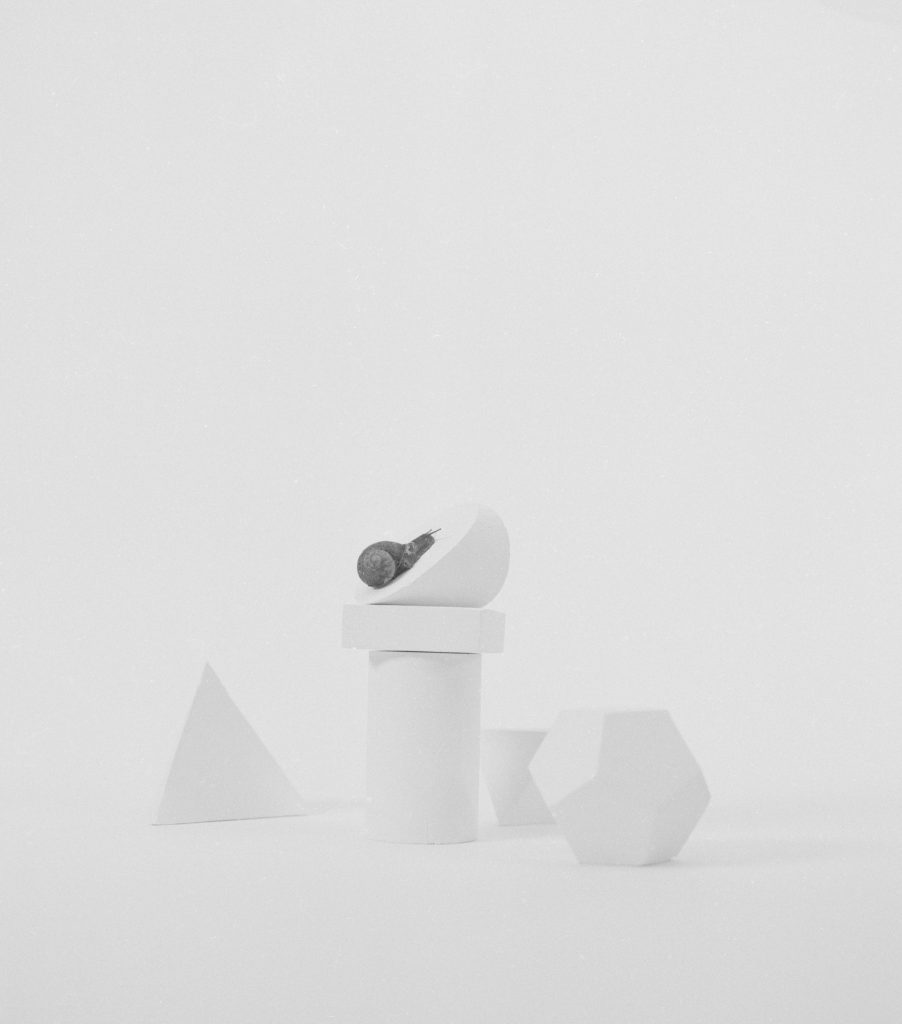
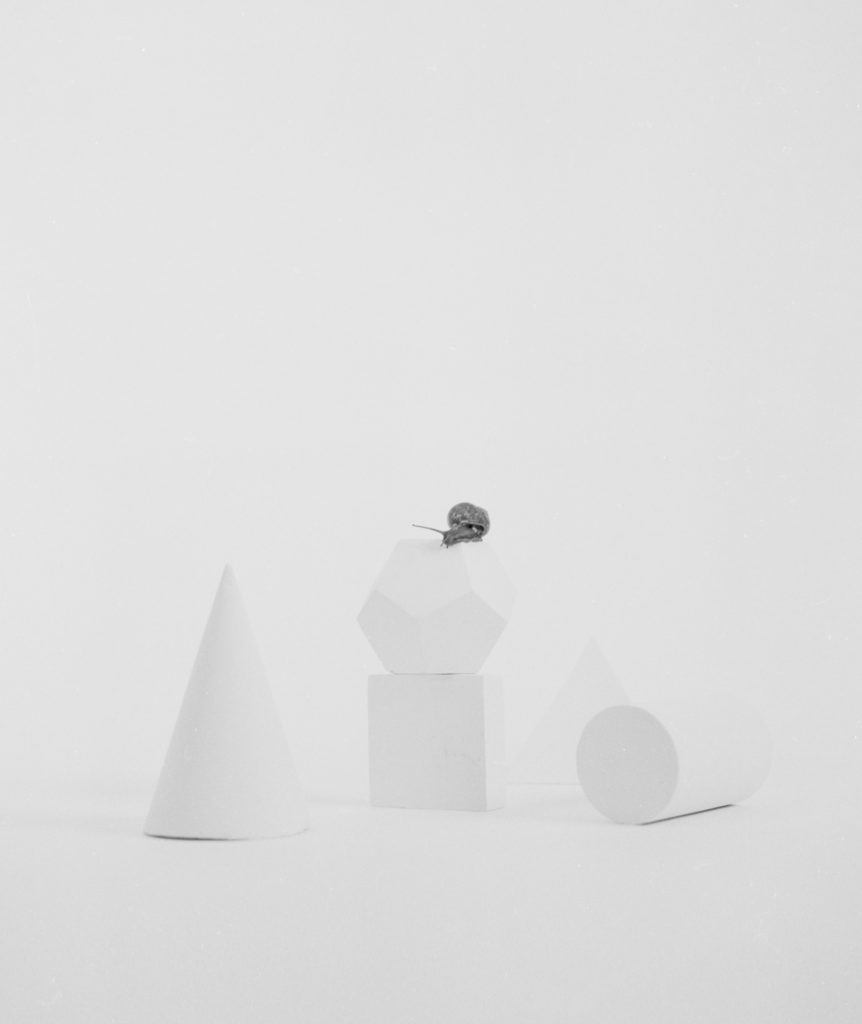
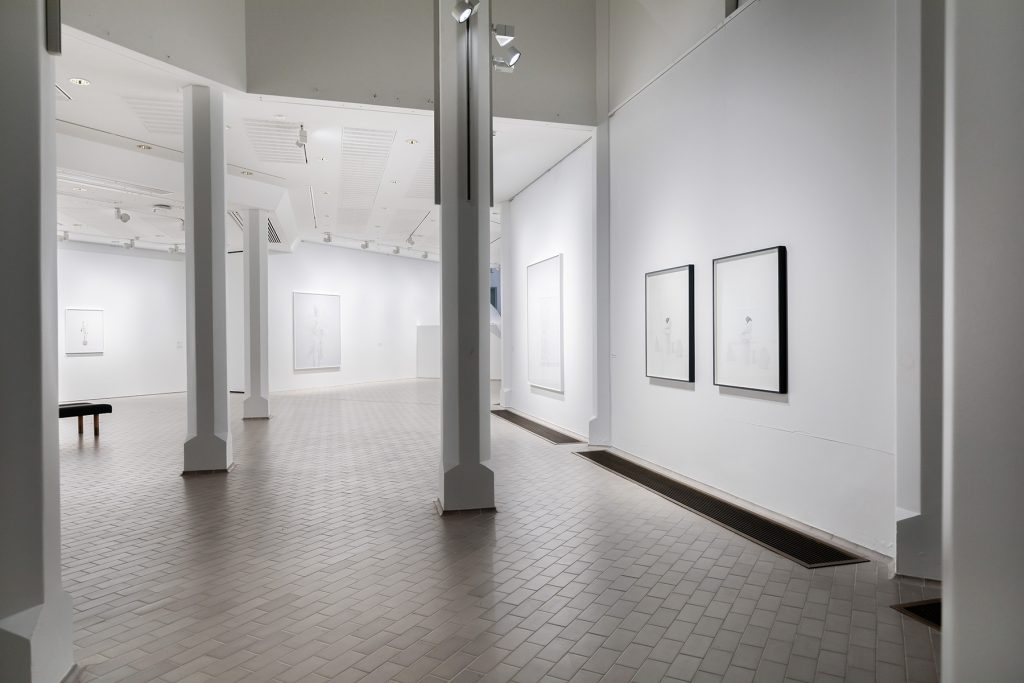
Still Life (Inertia Geometry) presents a minimalist composition that evokes some deep, fundamental questions about our perception of a world, assumed to be fully calculable yet its inherent poetics provoke a dialectal debate. Euclidean geometry, represented here in a number of non-reflective, geometric solids is investigated by a group of snails. In its simplicity at the first glance this work gradually reveals its underpinned universal complexity – and the conflicts that come with it. There are scientific and poetic aspects. One can sense a trace of melancholia but also of discord.
From the Renaissance to Modernism, these types of still life arrangements of geometric solids kept recurring throughout the visual arts. They tell a story of the obsession in science and philosophy of reductionism towards irreducible essences. Along comes the sober fact, that all atomic structures of solid matter are limited towards just six numbers of possible folds. Yet, Antas inconspicuous inclusion of a polyhedron gives us a hint towards potential complexities that go beyond crystalline matter – as well as all the related algebraic trajectories which already preoccupied Johannes Kepler’s mind.
They all point to an old paradox – If postulated, that everything in nature is built out of these simple and perfect geometric shapes, why we cannot perceive all of them at human scale?
Meanwhile, and in magnificent contrast, the snails crawl thoughtfully over these objects, perceiving these plane geometric surfaces with their organic, slimy bottom and amorphous topology. As in Renaissance still life painting, the draped cloth covering the hard edges, the snails are the perfect stand-in for non-euclidean geometry, as the much needed counterpart. The snail’s long investigation of these bodies consists of a multi-sensuous and multi-facetted act of touch, given from a living species to an inanimate object. Snails are not slow (an all-too human misunderstanding) but they are just more thorough.
What Antas entitled “Still Life” also refers to the temporal dimension of the piece in which we encounter different time scales. The slow moving snearls create a quasi still life for human perception. But eith the parenthesized “inertia geometry” in the title we may need to zoom out a bit, as all these bodies are not only in motion but also in slow progressing decay. The snearl’s action evokes a glacier-like transformation of a human-made linear structure. One could call this Poiēsis wins over Technē. Although there is a lot of friction and a lot of mucus needed to ease this friction.
Antas captured this battle in silver-bromide crystals of the black and white 16mm negative film and another small metamorphosis can be found in this process. He took the event “out of nature” by meticulously transforming it into a digital image, consisting of strictly non-organic pixels.
When later reproduced on a screen in a gallery, what we see is a documentation of another kind of public viewing. We contemplate art that is already contemplated by another species. An art work perceived in another space and in another temporality.
Before we rush off to see the next art work, we should be reminded what the origin of this type of still lives or vanias intended to give us a gentle reminder of our own mortality.
Nobody could have give a better interpretation of that than Sigfried Zielinski when he summarized a theorem of Theunissen:
“It is not us who have time, but time has us”.
Caspar Stracke – Berlin 2023
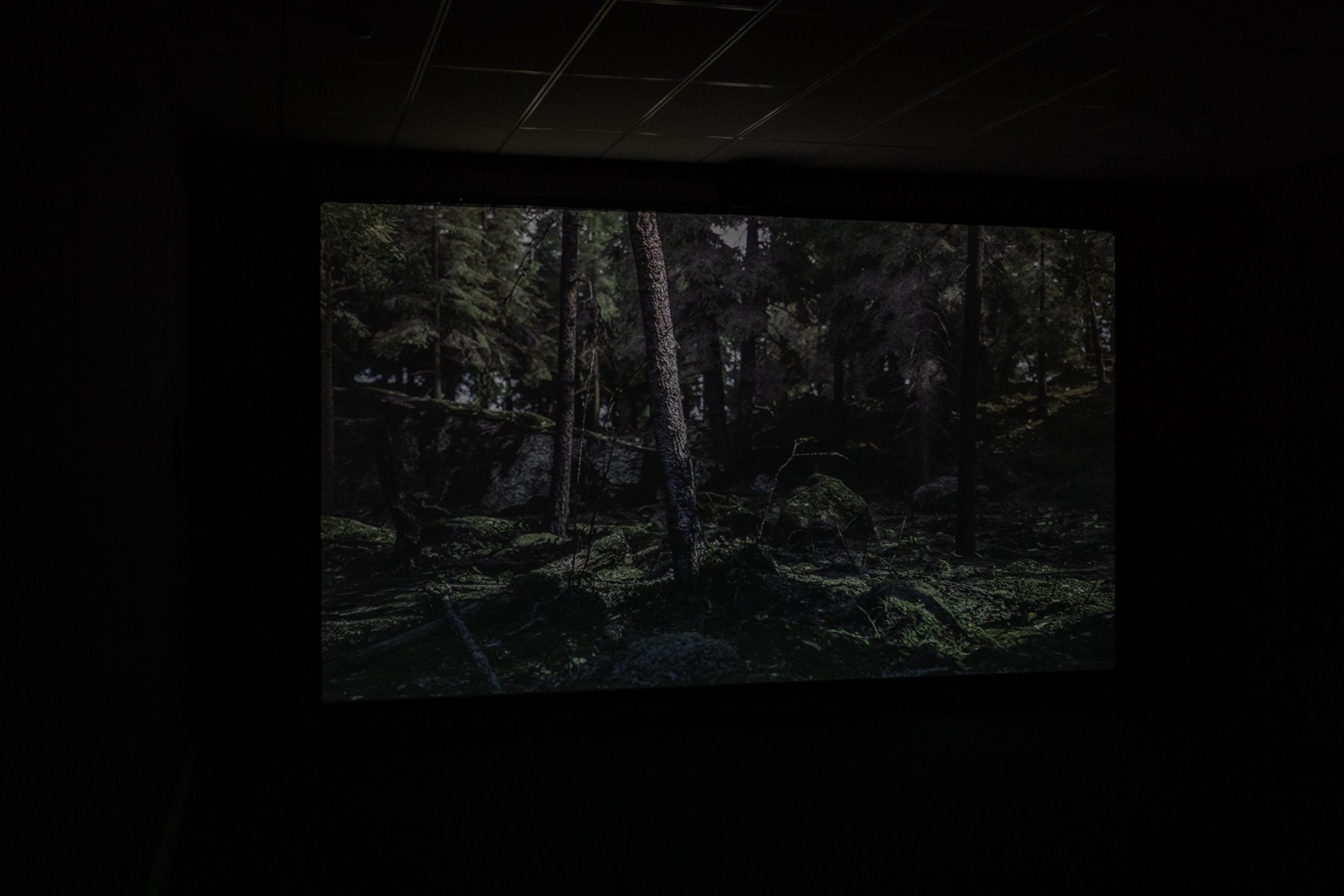
Diurnal Landscape
2023
Realtime generative animation with sound
Poikilo Edition duration: 22.5 – 27.7 2023
Artist, programmer and producer: Axel Antas
Programming: Sam Steer
Sound: Gordon Hempton
The work is a slow meditation of a digitised forest scene. The duration of this exhibition is linked to the works duration where the scene changes throughout. We can observe the landscape in morning light at the start of the exhibition. Towards the end of the exhibition the landscape goes towards nighttime where the scene is in total darkness where only a few outlines of trees can be seen. When the exhibition ends the landscape will be in darkness. Each visitor will have a different experience and the full film is only possible to grasp as an idea.
In contrast to the digital landscape we have a soundtrack that is based on real field recordings that changes for the duration of the film. The sound is by sound recording specialist Gordon Hempton who has worked on a project where he captures sound in natural environments that are void of any human created sounds. Thus the field recording is the sound from a forest without human presence, which links the uninhabited digital landscape with the sound.
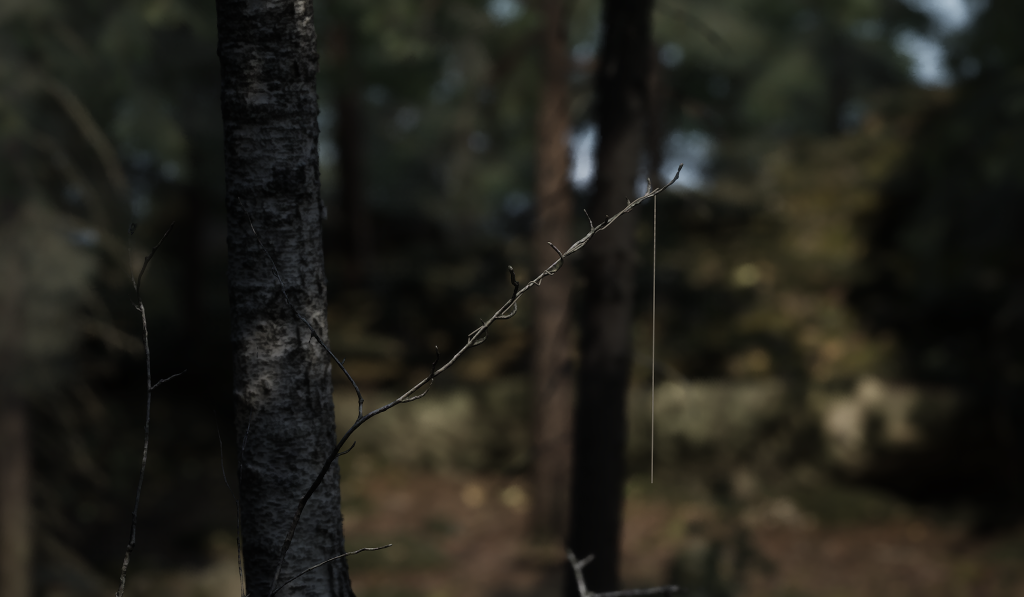
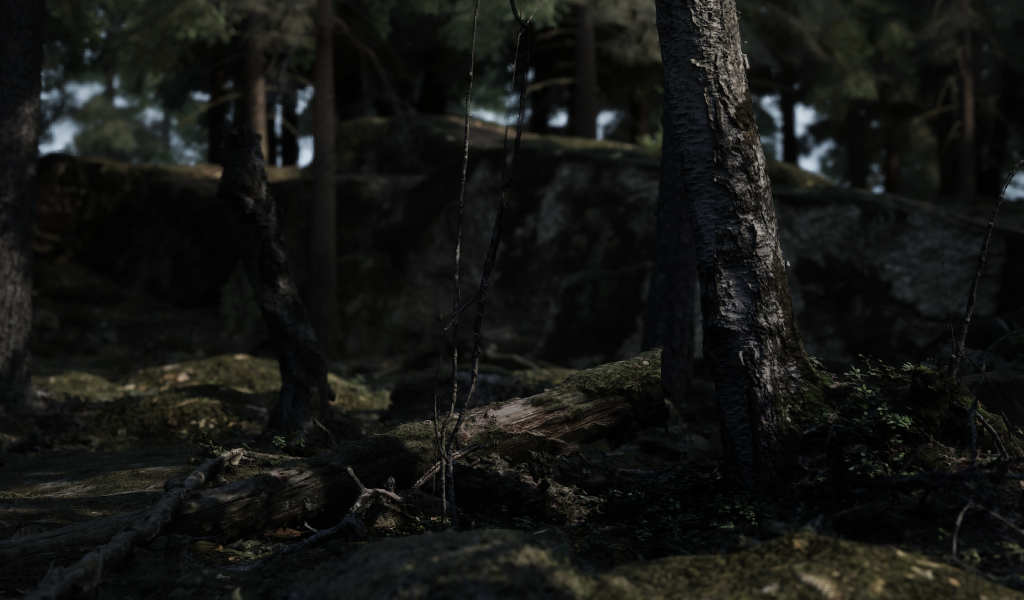
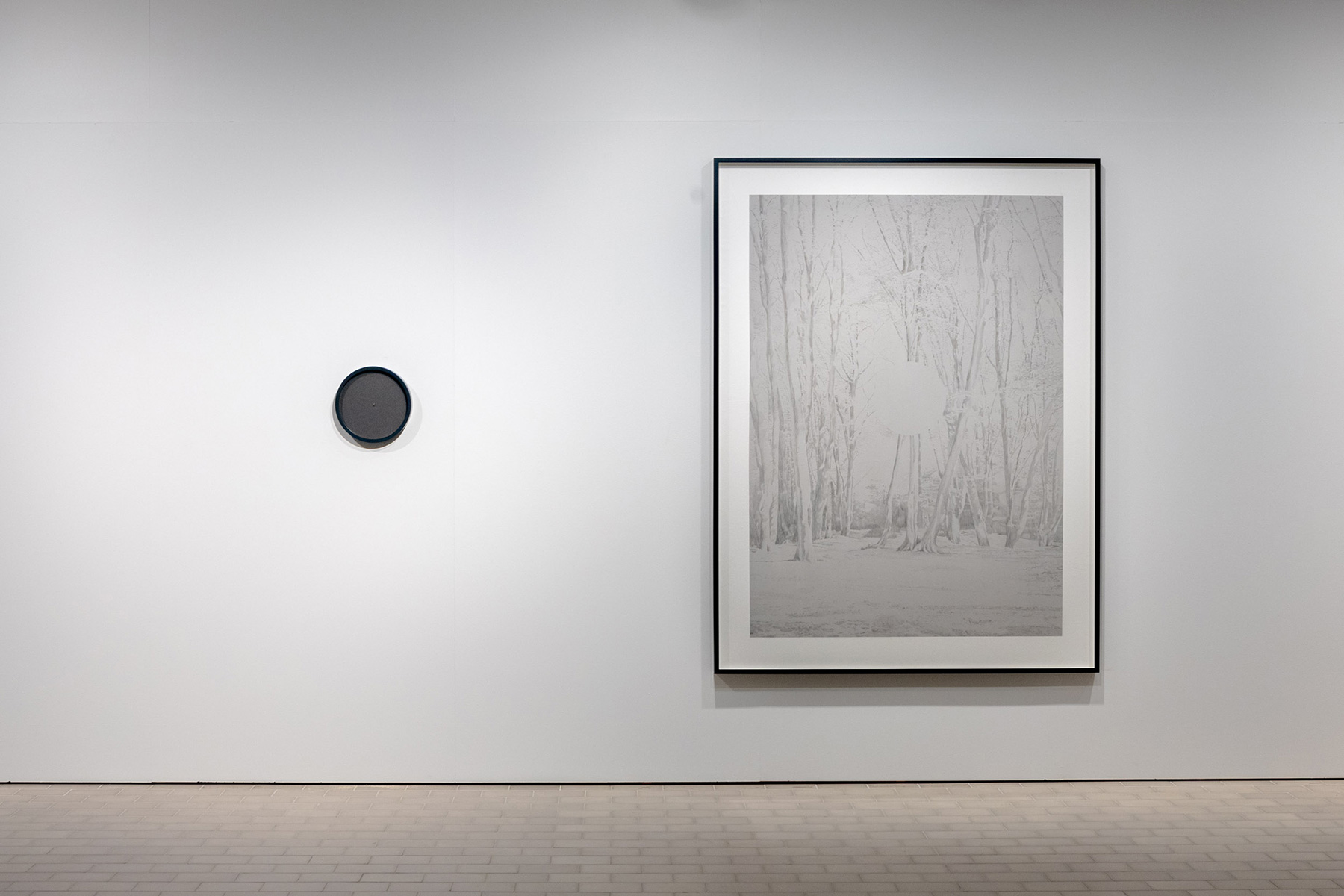
A metalpoint drawing is made by applying a stylus—a thin metal rod inserted into a holder—to a prepared surface. As the stylus moves across the textured ground, it deposits miniscule particles of metal and creates a mark. The ground is based on Cennino Cennini’s 15th century recipe.
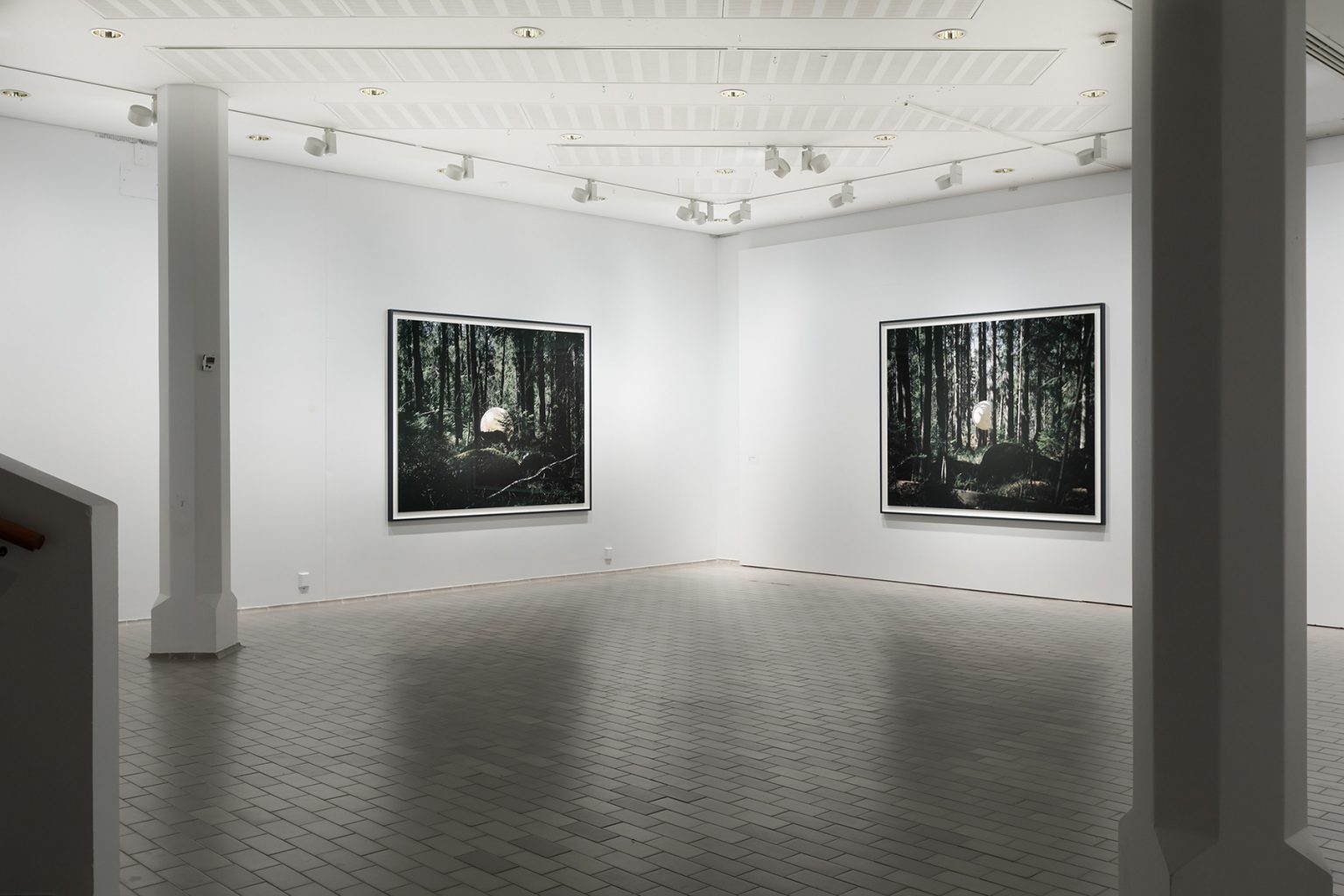
Lines describing a circle
2017
Super 16 mm film converted to HD video
Duration 3:00 minutes
For his video work Lines describing a circle (2016), Antas has filmed close-ups of his parents’ hands, who are seen drawing the shape of a circle over and over again. The end result is rarely close to perfect. Circle drawing, and the meditative thinking that goes with it, is linked to the Zen Buddhist ensō tradition of drawing a circle with brush and ink every day. A perfect circle drawn with one or two free strokes of the brush indicates a moment when one’s mind is free and enlightened and the body is at its most creative.
The circle drawn in the ensō tradition can be open or closed. The open circle with its narrow shape is associated with the idea of wabi-sabi, the beauty of imperfection. With its imperfections, the open circle allows for further movement and development. The circles created by Antas’ parents are symbolic of imperfection and fragility. They paint a poetic picture of our life cycle, tying together its beginning and end with a playful, light, yet slightly mournful mood.
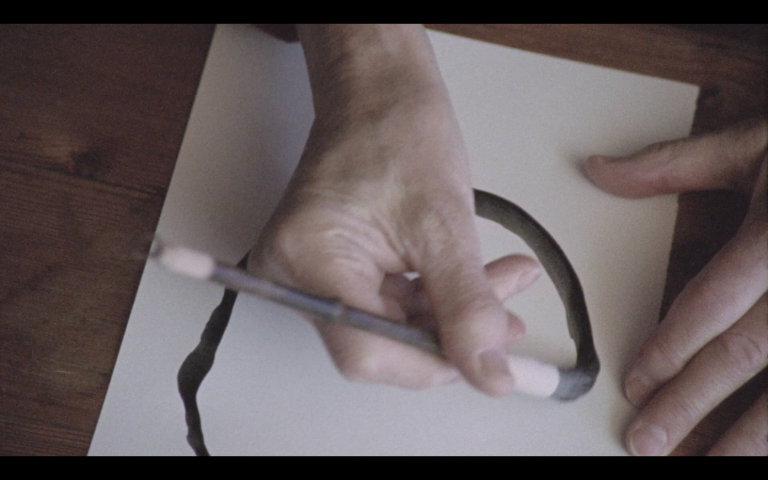
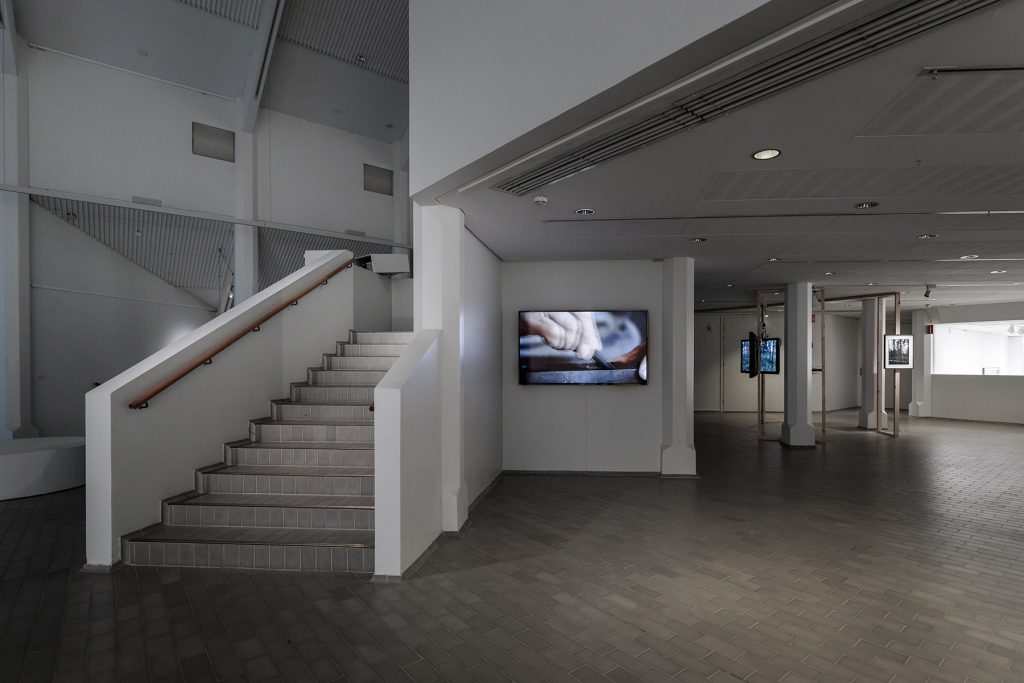
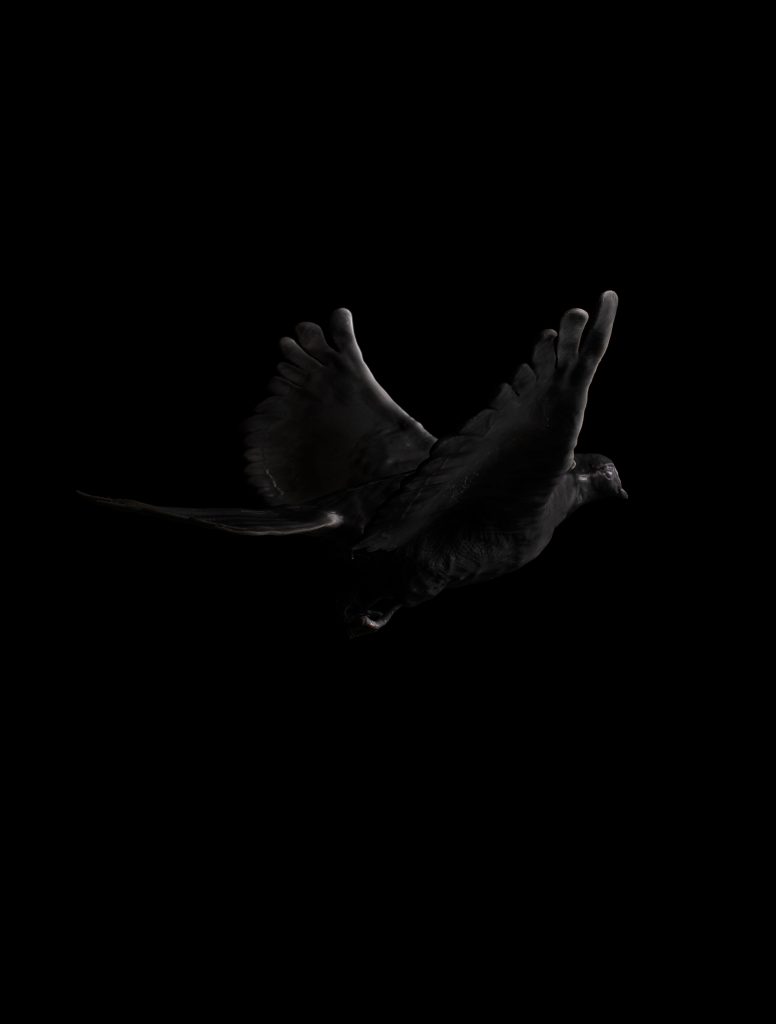
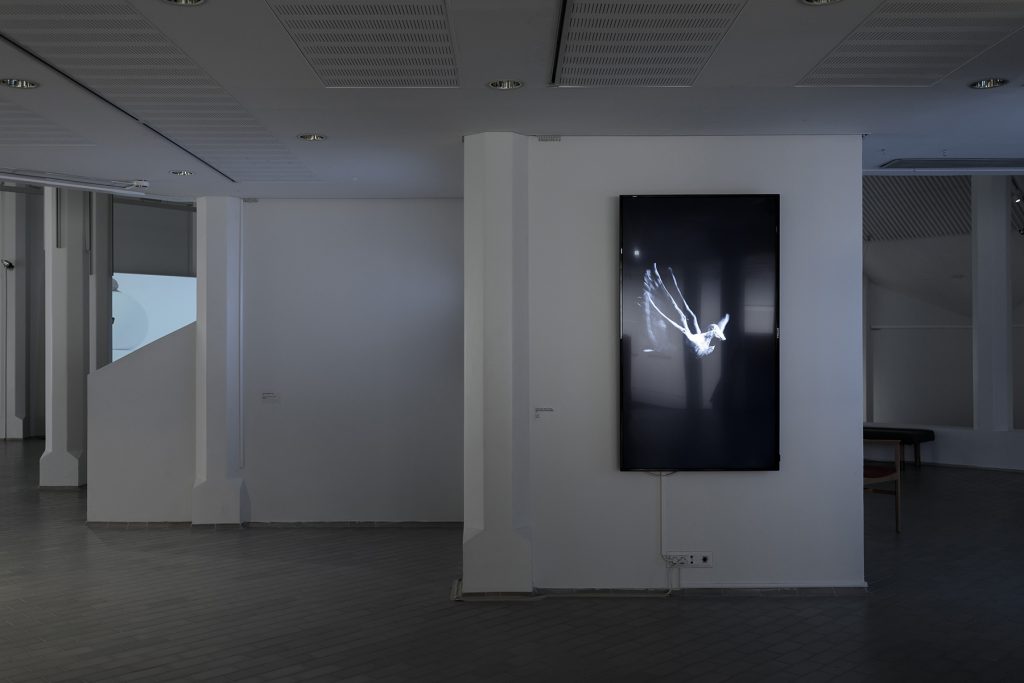
A Passenger pigeon flying (After Eadweard Muybridge)
2021
Digital film
Duration 12:00 minutes
In this stop motion animation we see a passenger pigeon fly, a species that became extinct in the early 20th century. Antas’s film refers to the early motion-picture series by Eadweard Muybridge (1830-1904). Muybridge was an English-born photographer, a pioneer and innovator of film projection. Muybridge is known for his images of American life, particularly his series of motion pictures. The moving pigeon was a species native to North America. Its name refers to the migratory lifestyle of the passenger pigeon. The Cincinnati Zoo adopted the passenger pigeon in 1902, it was named Martha. In 1909, Martha and her two male companions were the last known representatives of their species. In April of that year, one of the males died. George, the last male of the species, died on 10 July 1910. Martha lived a long life, she was found breathless on the floor of her cage on 1 September 1914.
Untitled (sketch of a tree)
2010
Super 8 mm film
Duration 3:40 minutes
Pencil drawing
In a remote and marshy nature reserve in Taalainmaa, Sweden, lives what is believed to be the oldest tree in the world. The spruce is quite modest in appearance, but it grows from a rootstock that is around 10,000 years old. The making of Untitled (sketch of a tree) has required long term background research from the artist. The exact location of the tree has remained known only to few for fear of mass tourism, but Antas received permission to visit. The artist filmed the tree for three minutes on Super 8mm film, and spent the same amount of time making a pencil drawing. The brevity of the visit was deliberate, the time spent becomes insignificant when compared to the ten thousand years of Old Tjikko’s existence.
The projector projects the image of the tree onto the floor, the ground from which the tree is supposed to grow. A barely visible image of the tree and its bushy trunk emerges from the image. 8mm film runs from the projector to the floor and then to the ceiling and back down, creating both a temporal and spatial experience of the object of the work. The artist used Super 8 mm film, a technique that belongs to a bygone era. The film material reflects the precise physical dimensions of the tree. It curves in space, so that the temporality of the work is not only visually perceived but also spatially experienced.
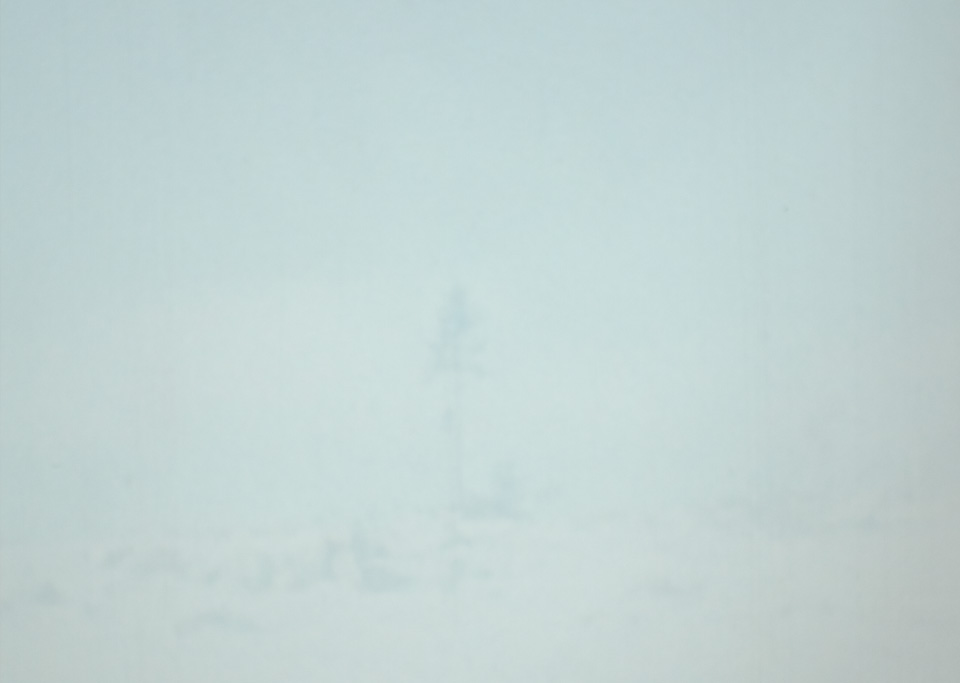
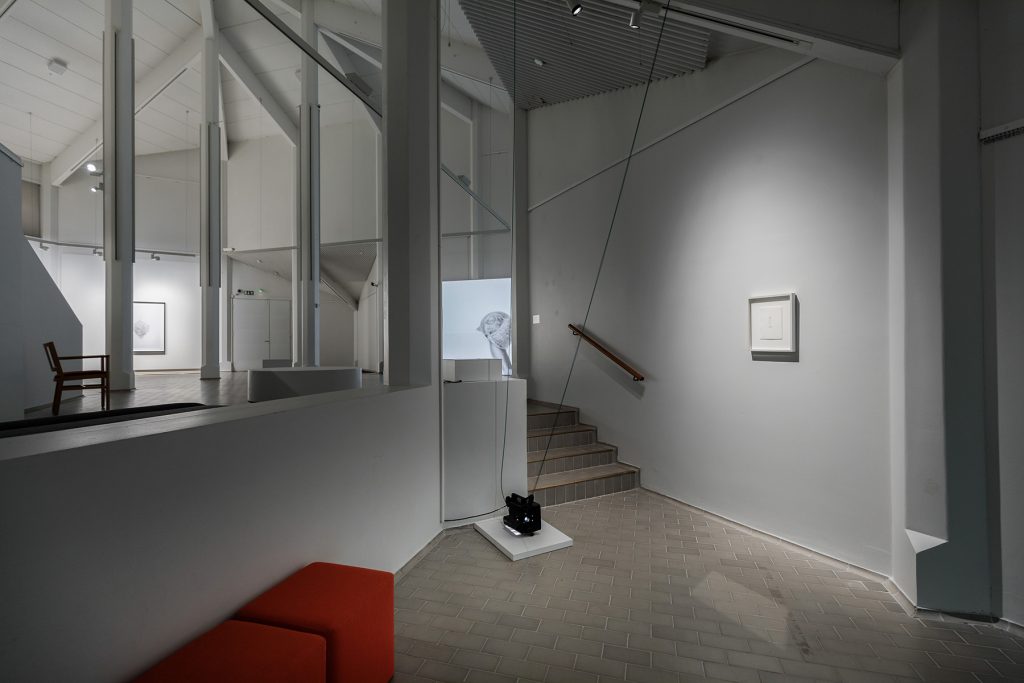
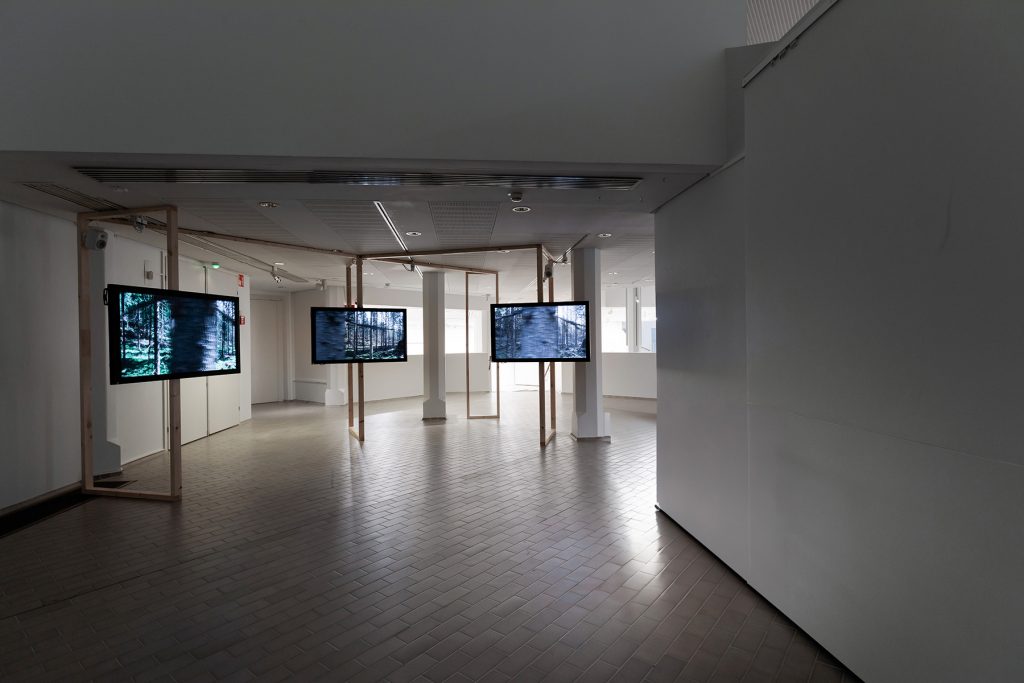
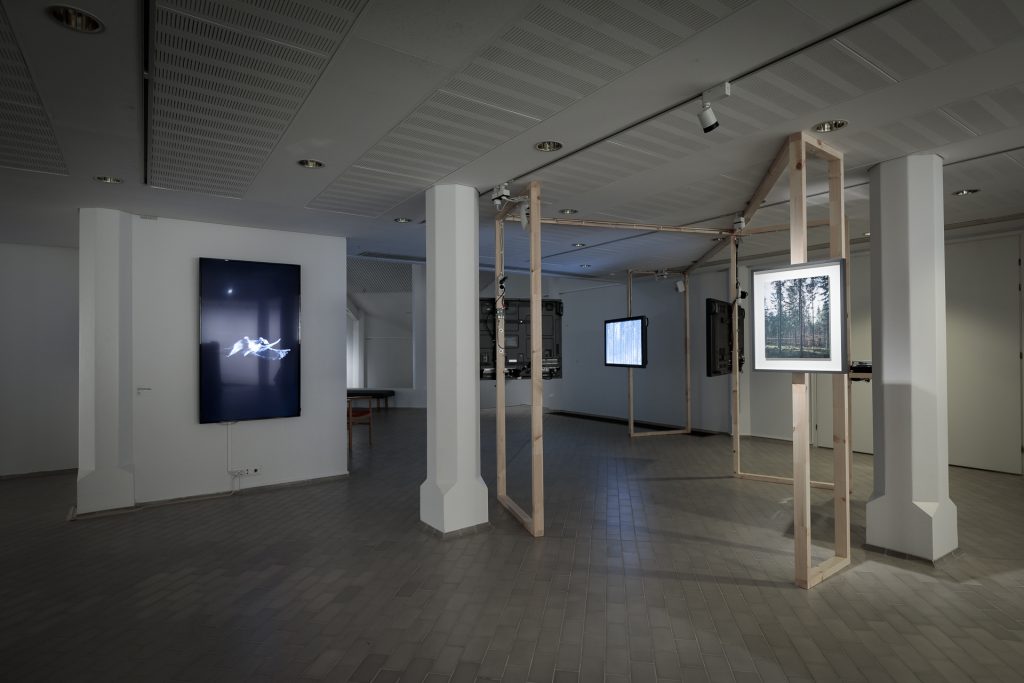
Long Player
2015
3-channel video installation
Super 16 mm film converted to HD film, Soundtrack from an analogue turntable
C-print
The video installation Long Player attempts to view different time periods simultaneously. The starting point of the work is a circular structure erected in a forest in southern Finland. In this context, it can be seen as a temporary sculpture or as a purpose-built structure for a landscape camera. The camera travels along the circular structure, capturing the same landscape at different times of the day and year. The material captured on film does not form a beginning, a middle or an end but a single moment expands into an endless spiralling universe.
The format of the work allows us to reflect on our relationship with time and memory. We can see several alternative possibilities at the same time and examine our understanding of the experience of time and its temporality in a single moment. On the other hand, Antas looks at the film camera and material as an object, exploiting their material properties in an attempt to give the moment a physical manifestation. The work is shot on 16 mm film. 1 roll of film = 11 minutes = 122 metres = 1 circular lap. The circular structure is 122 metres long, 4 metres high and the camera rotates around the structure in 11 minutes. In addition to the film, the work includes a soundtrack of ambient sounds and a photograph of the structure.
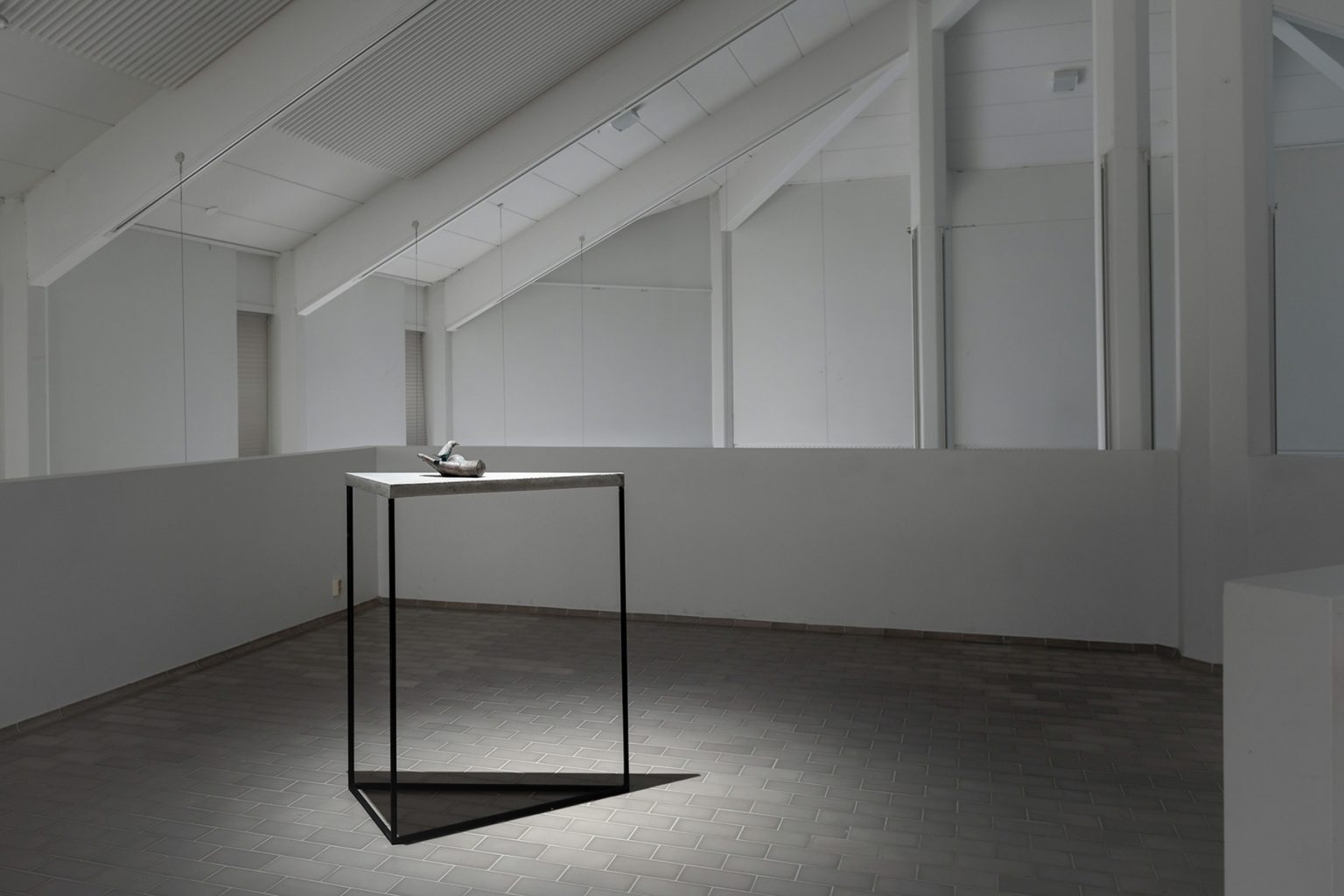
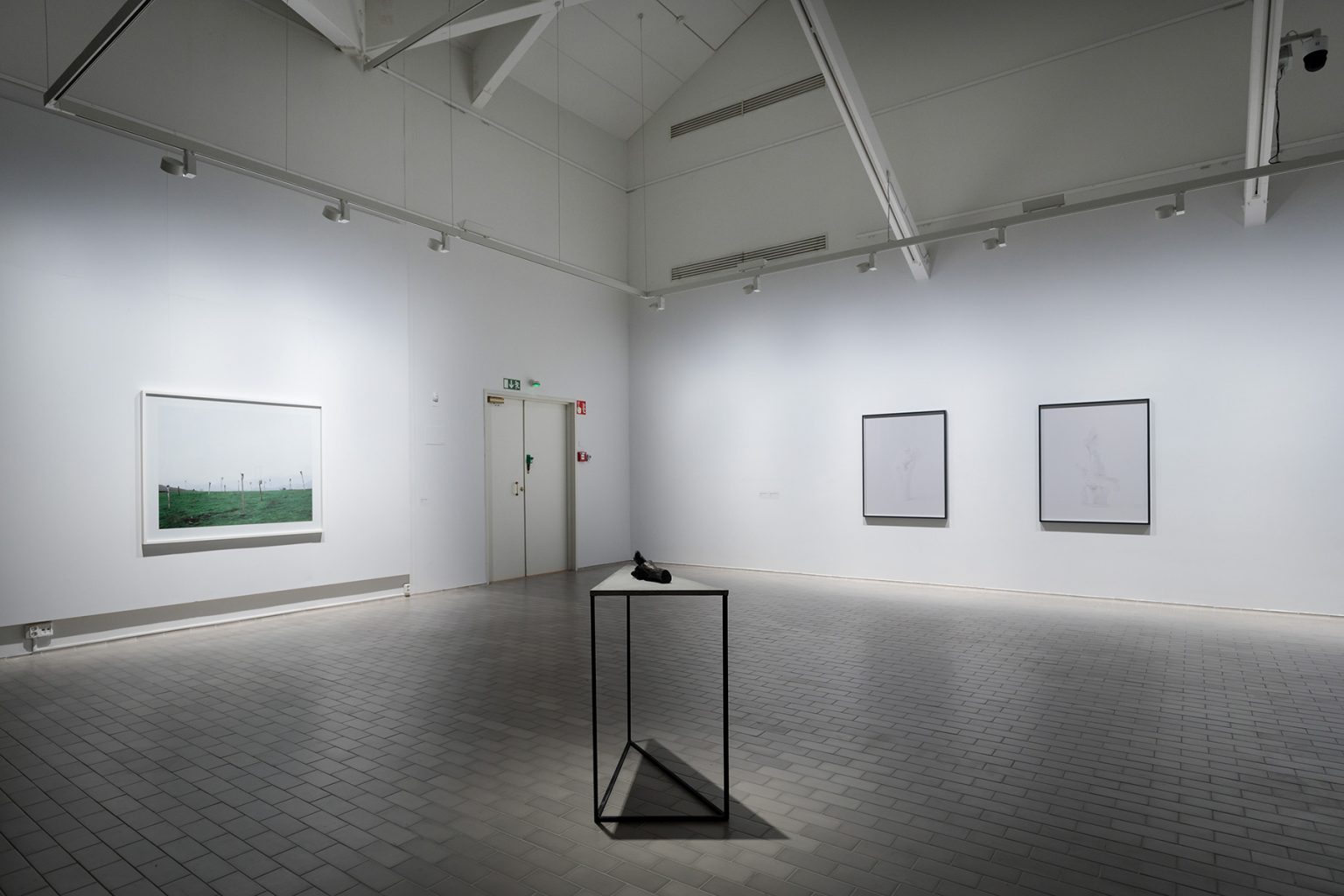
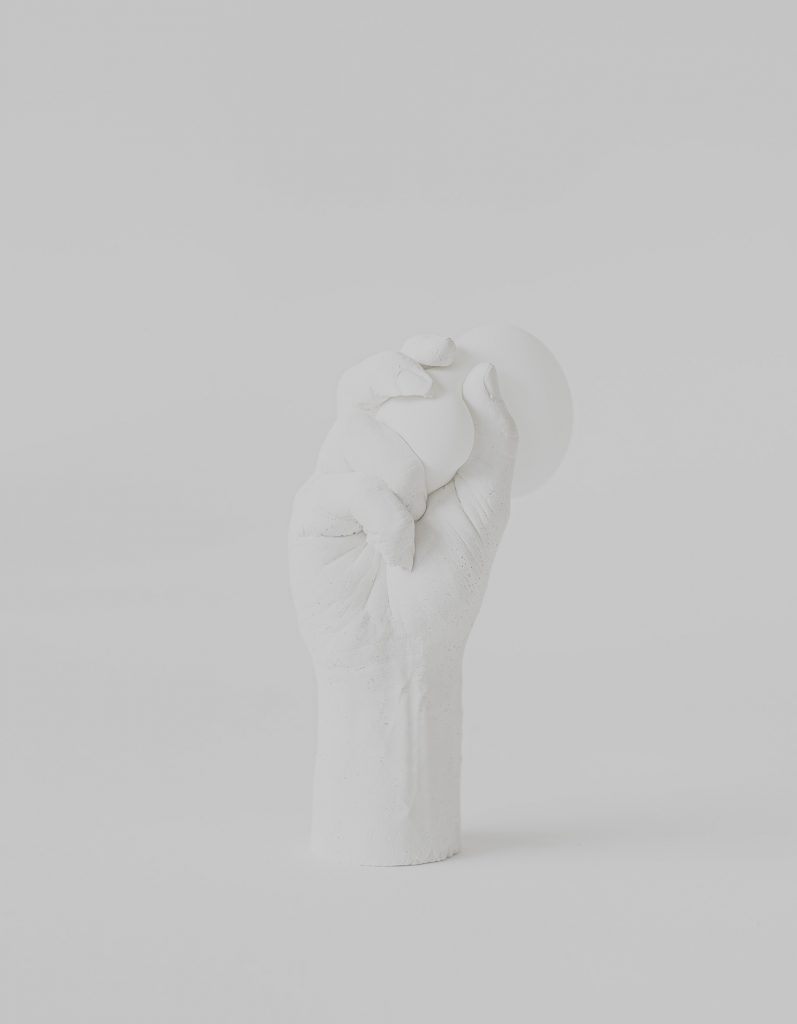
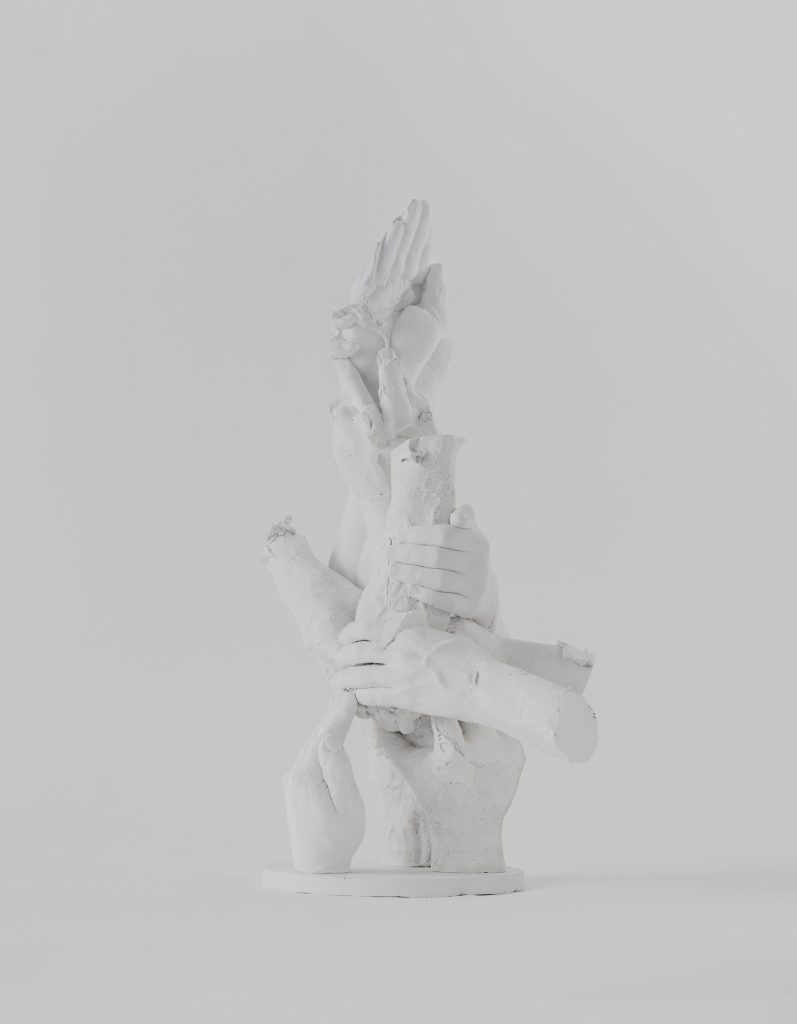
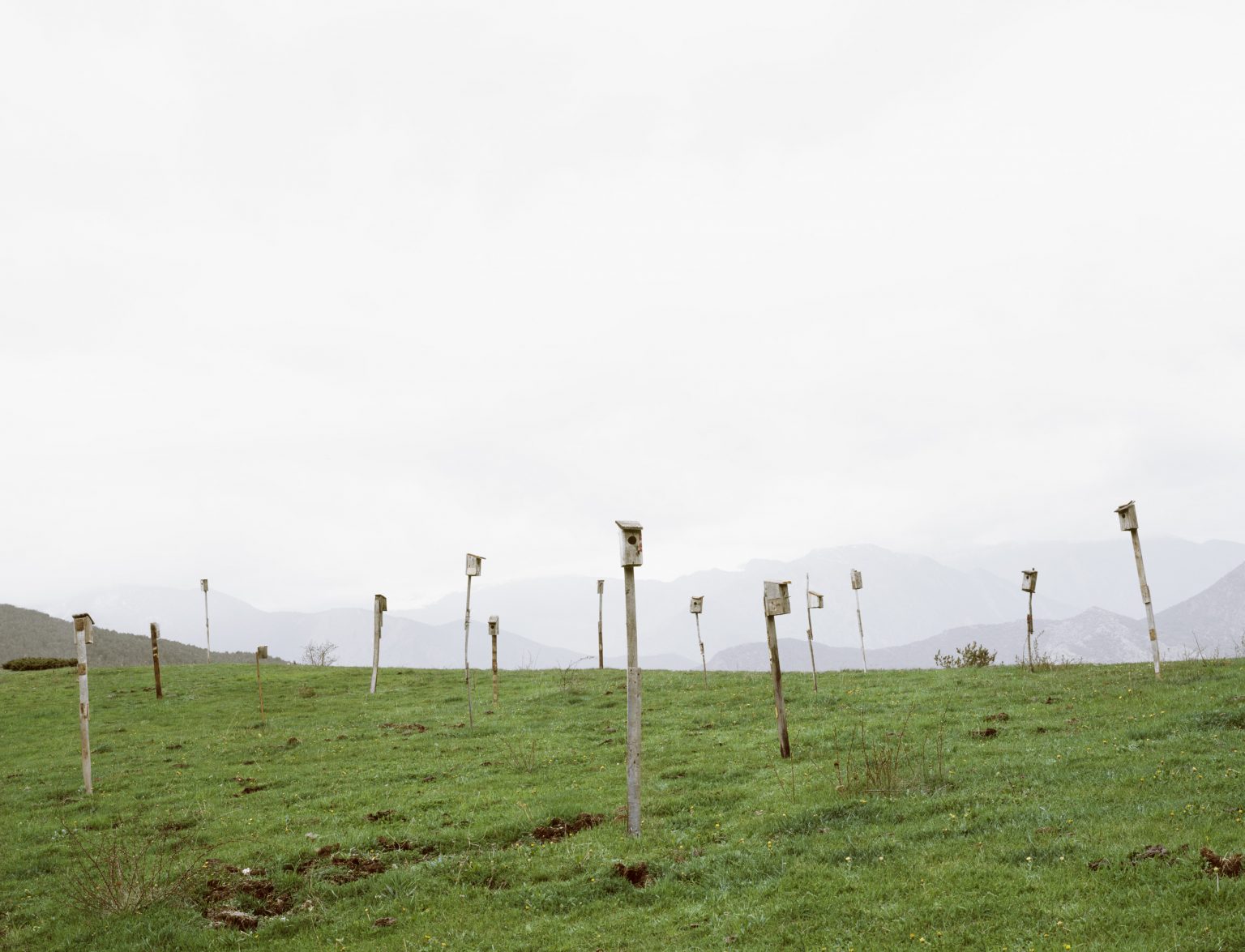
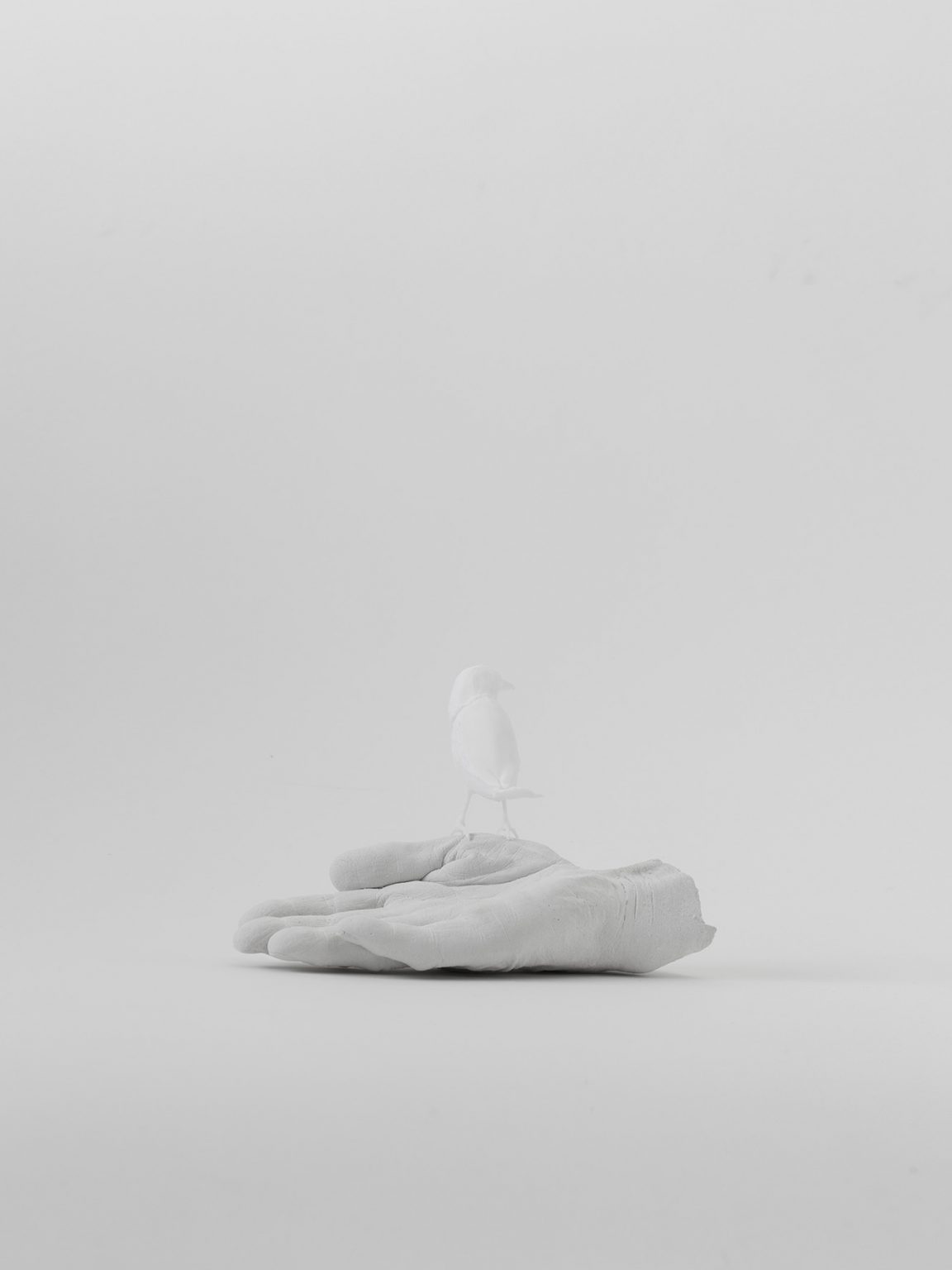
White, Whiter, White
White, adjacent pink, and their confidant black can all be considered outcasts in a physical definition of the visible spectrum of light waves. The eye processes, and you see white when a wavelength is reflected off an object. An absence of or casting off. Yet, a mixture of red, blue, and green light creates white, as we see it on a screen.
❍
Going through paper stocks in the studio, names include Context White, LOOP eco, and Sylvain Coat. The latter belonged to a woodland deity. Each sheet is lit, from above, by a mix of bright white and daylight bulbs — the best for workspaces. Warmth is measured in Kelvins. Candlelight is around two thousand ‘K’.
Also seen beneath artificial light is a set of ageing, untrustworthy off-white paint swatches. Found in a cupboard draw from when we were going to paint the attic. Paperwhite, Jakes Place, Bygone Times, Memoir, Luminair. Plus, a town in Dorset, England, and their old and very local term for a spider’s web.
❍
Bright white fills my home’s sunroom as the clouds break on a precious day between winter and spring. Beyond any question of fidelity. Where black and white may become interchangeable, companions, friends. Gleaming with reference, this space between the clouds. Achromatic. A thought bubble, foamy drawn cloud, a daydream. A vast space of intimate immensity where there is no setting other than itself.
The morning’s light flatters the surface of my daughter’s white woollen hat –– illuminating broken, wispy acrylic strands around the circumference. There are nags in the fabric like witness marks. The knit perfectly holds the form of her head from before bed the night before.
A witness mark may be a dimple, a burr, a raised ridge, or a snagging imperfection. Cut back. One of many possible floors on a cast form. Raised ‘parting lines’ or ‘sink marks’; wavy, undulating dips across the surface of a cast form. A witness mark is also a cut, a scratch, an applied line defining paired parts’ location.
❍
Comparative, as in, whiter. White as in teeth, ageing, like paint swatches. A picket fence. Paula’s hair; a shock of peroxide blond. White, as in a broken centre marking on an open stretch of road. As in white goods, pulled away from the wall. A name in the snow. Plastic, resting in foam on a beach. Under the arms and around the neck of a decade-old white t-shirt. A white circle, a sphere, an eclipse, revealed by its shadow-twined form.
Jamie George – London 2023
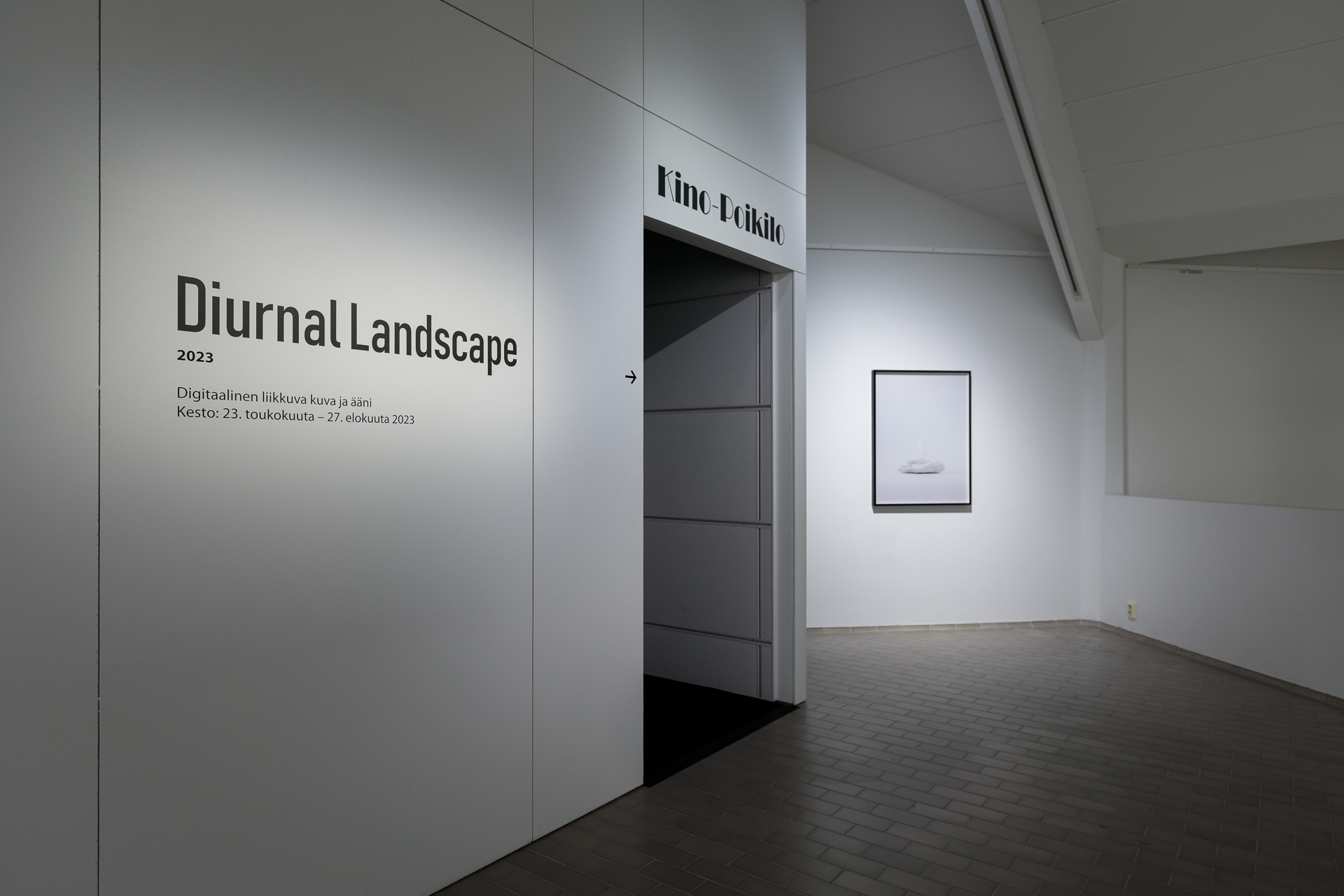
24.5.–27.8.2023
Poikilo Museum
Varuskuntakatu 11, 45100 Kouvola
Open:
Tue-Fri 11-18
Sa-Su 12-17
Closed Monday
Installation images Timo Tuviala, Tavaton media.